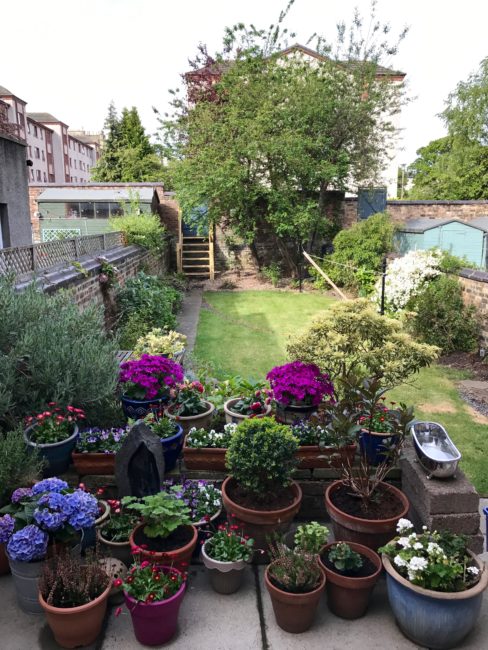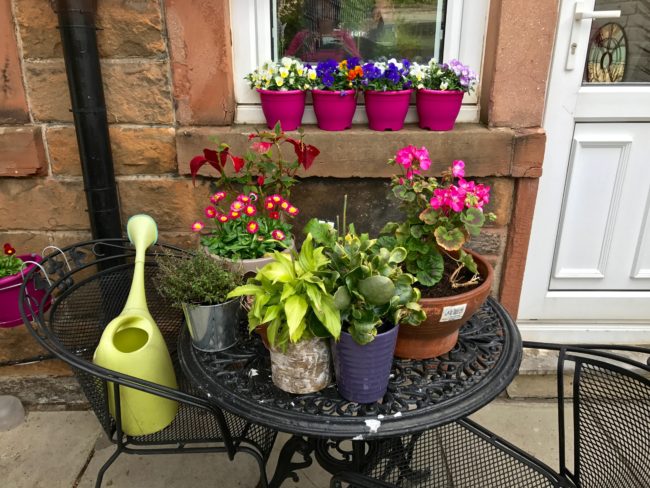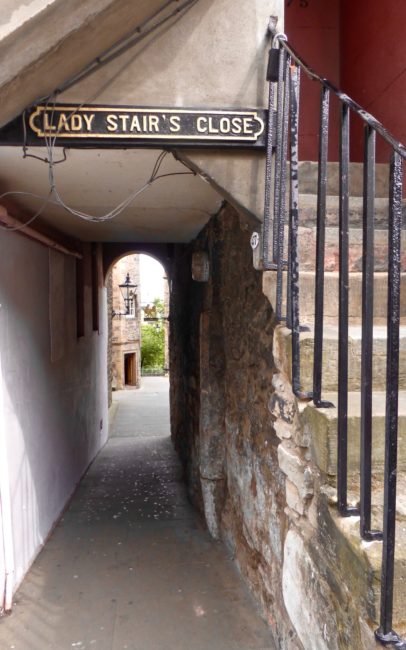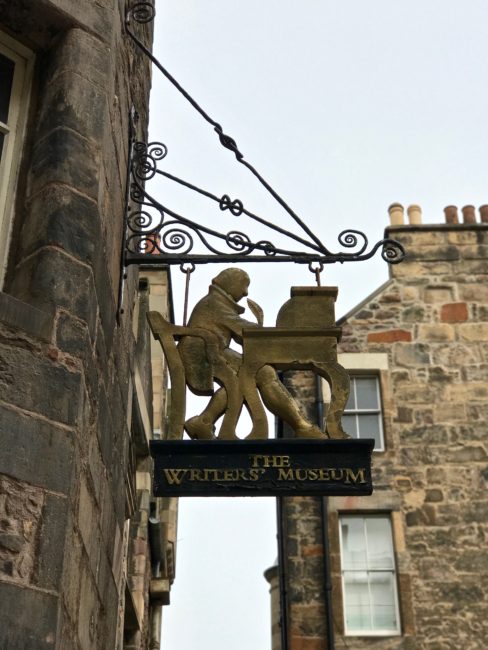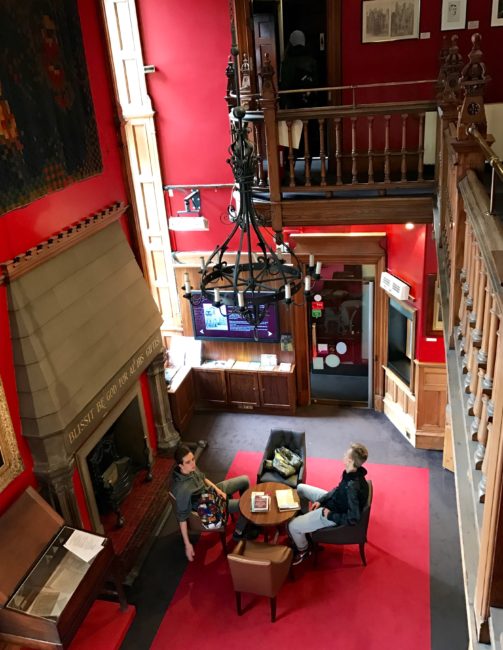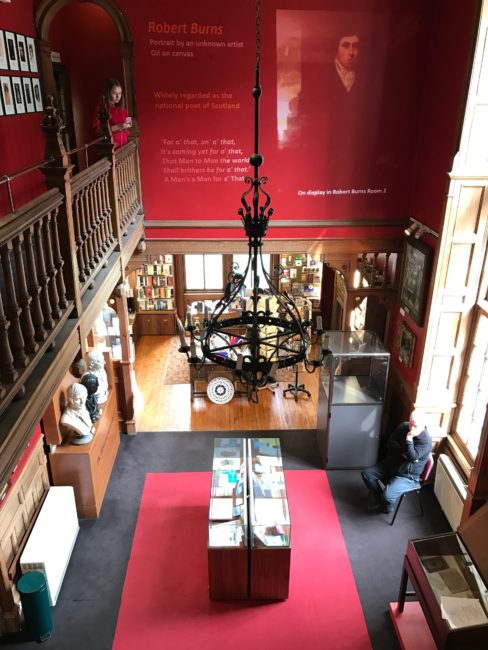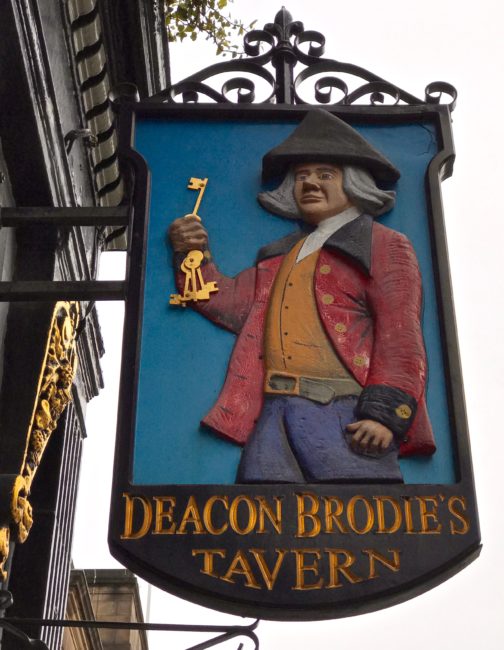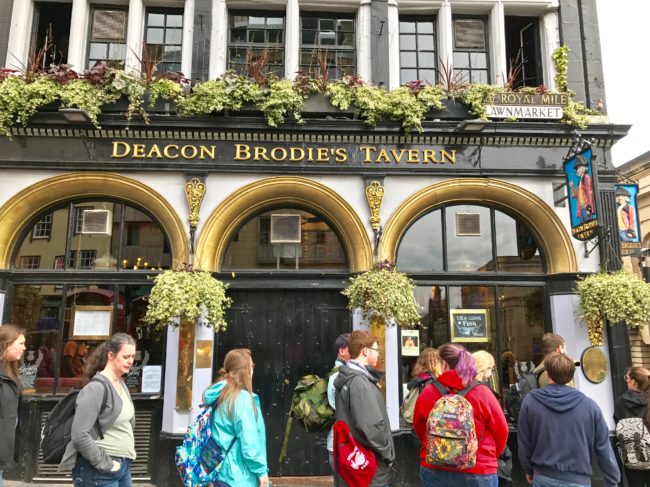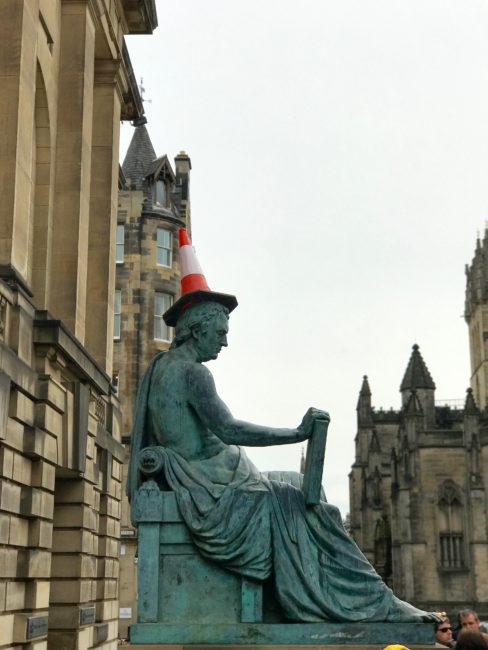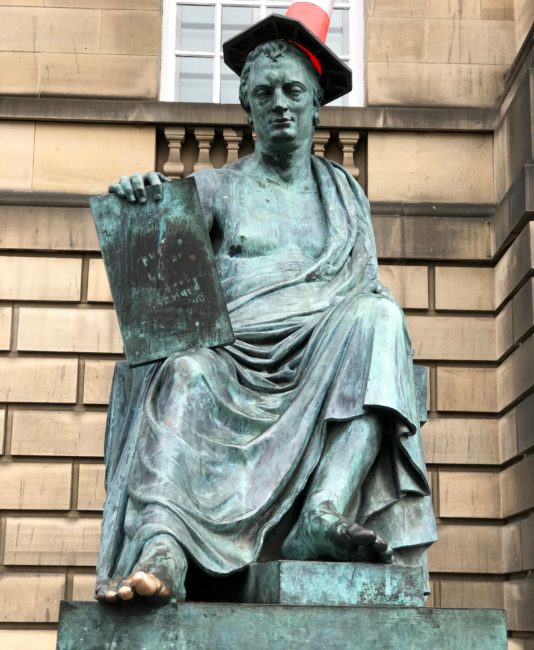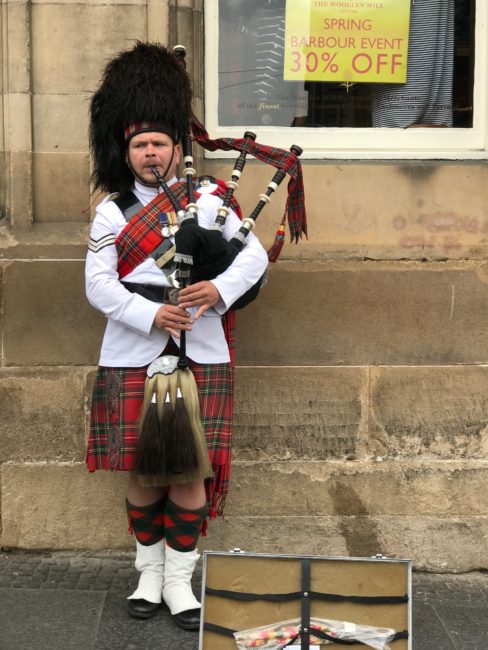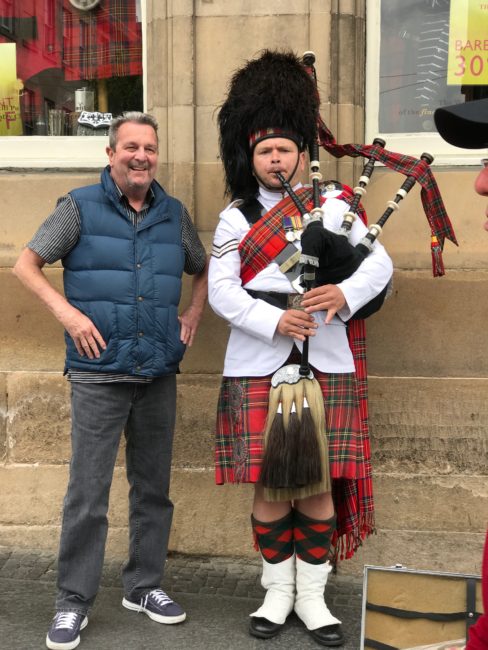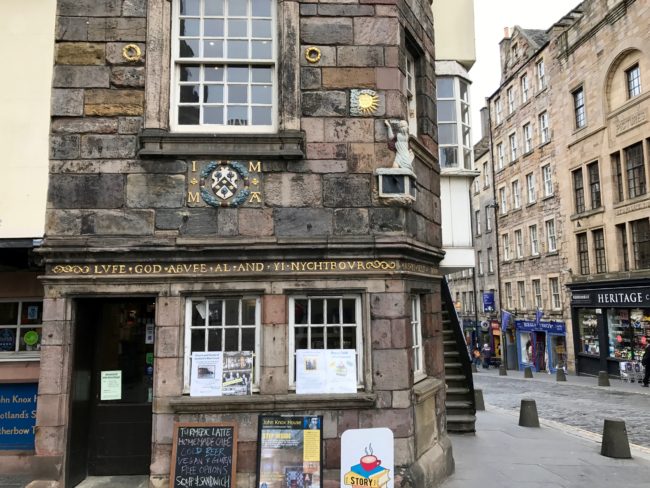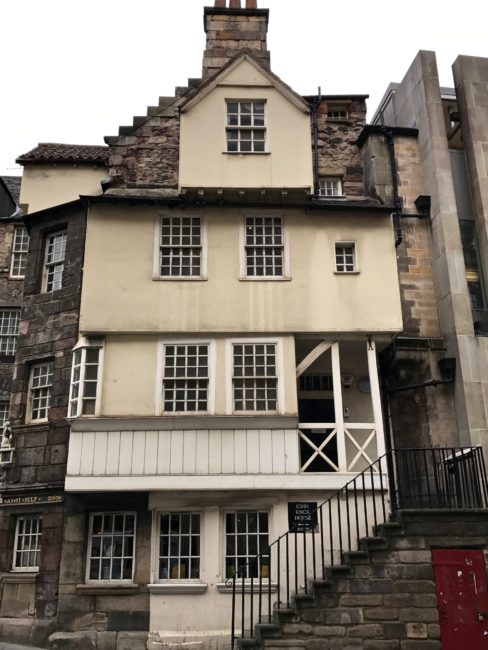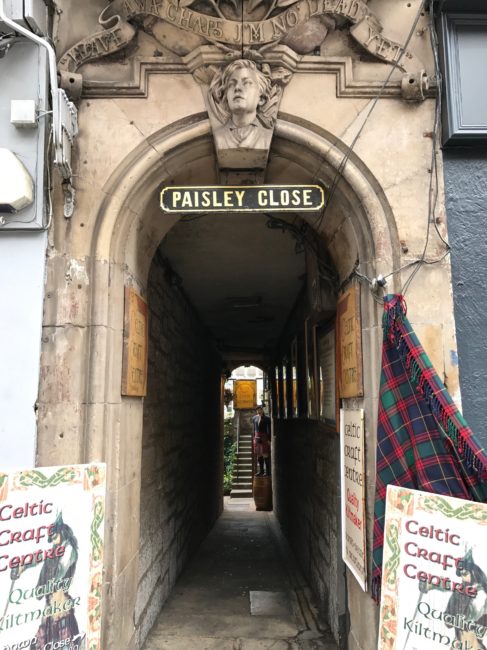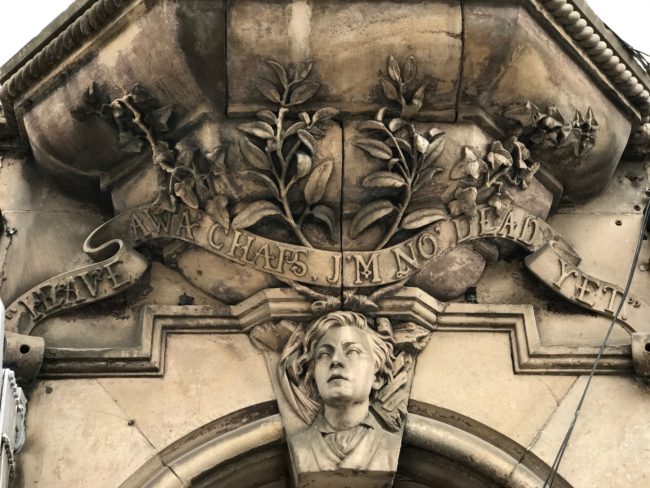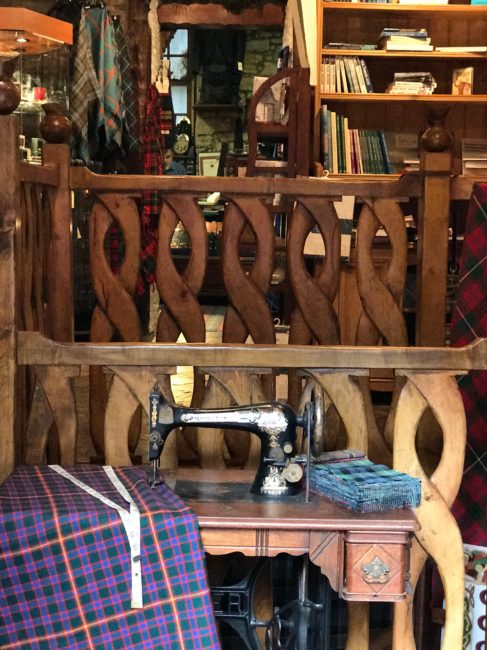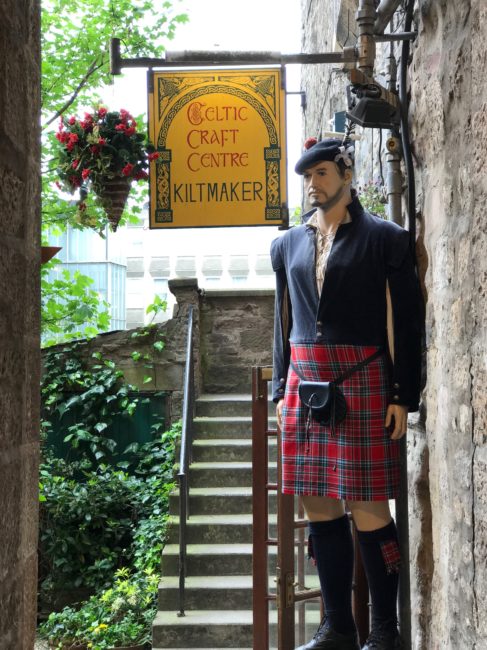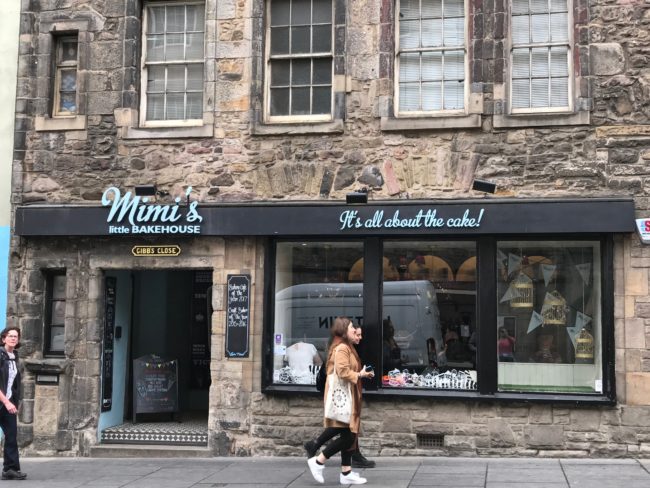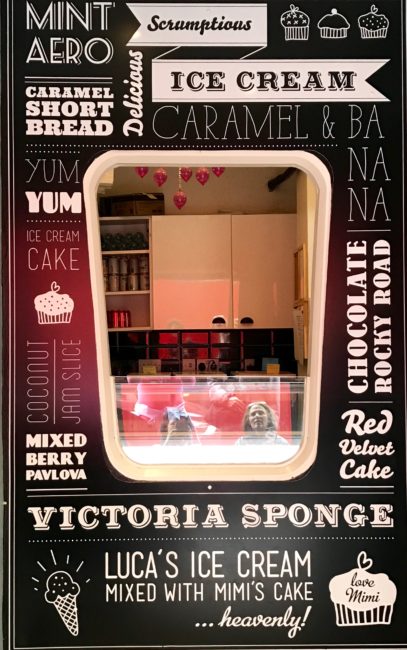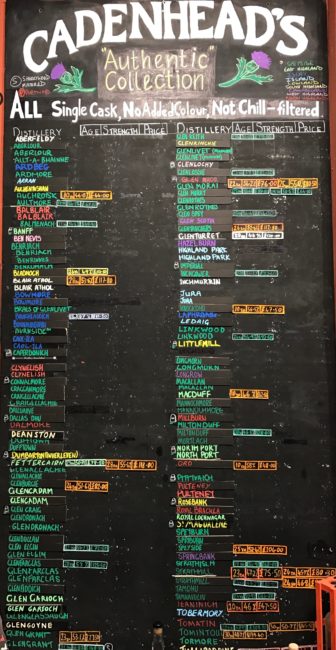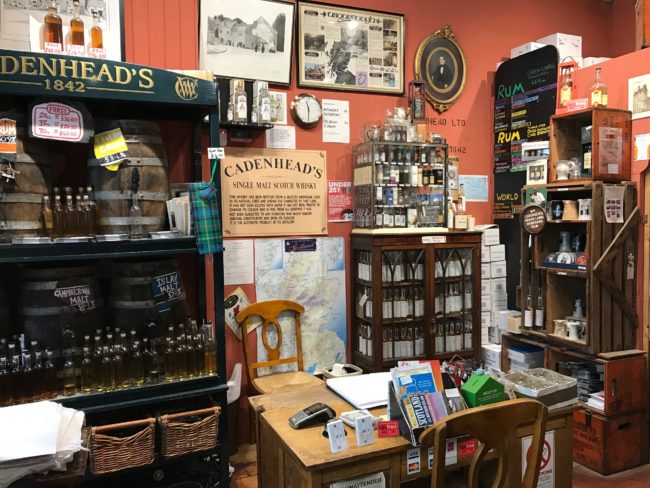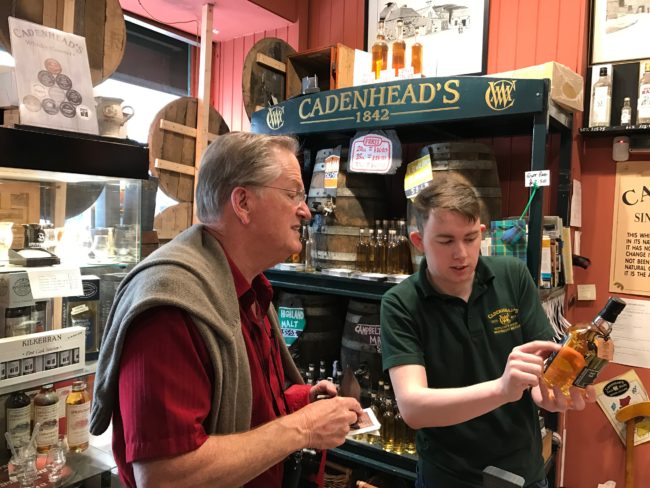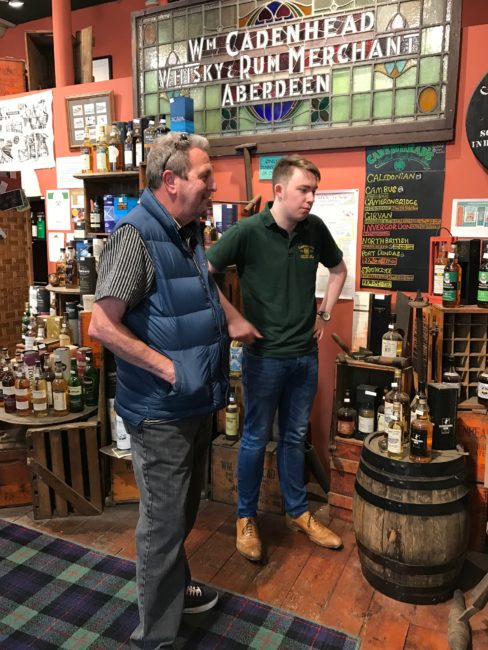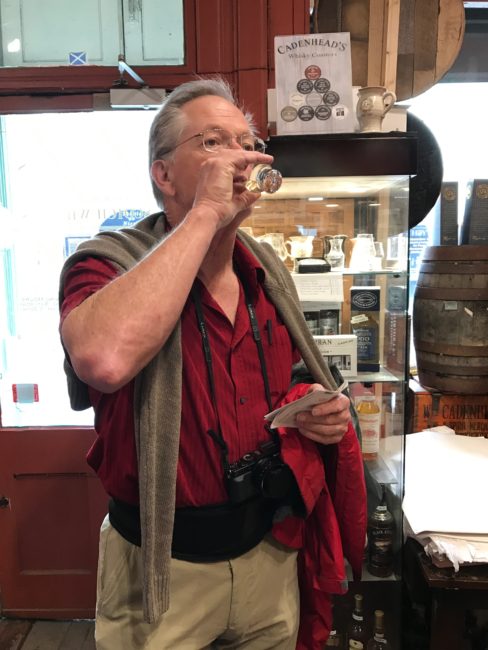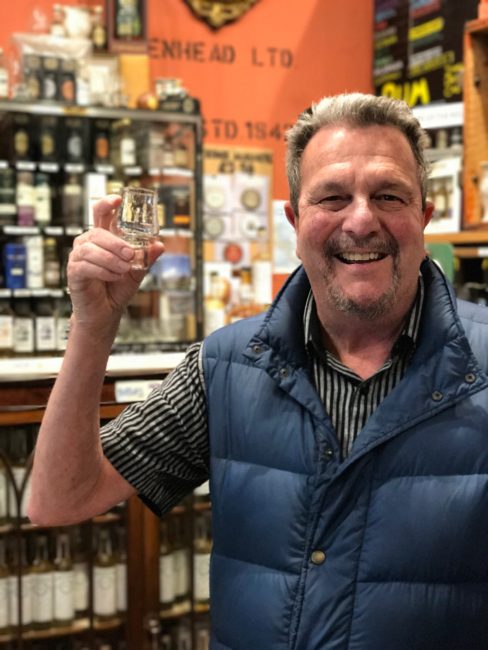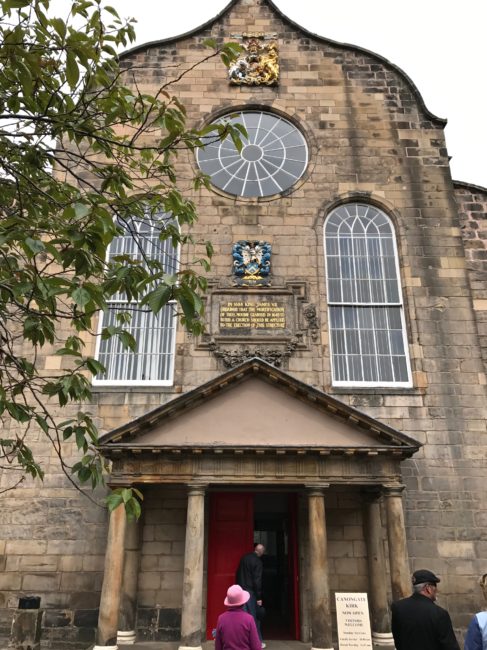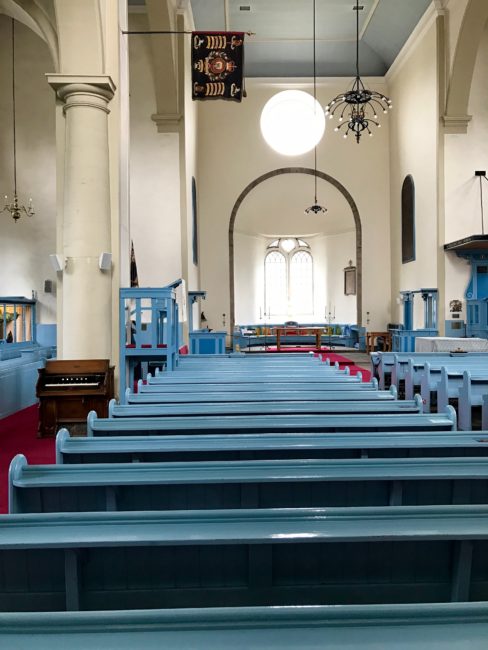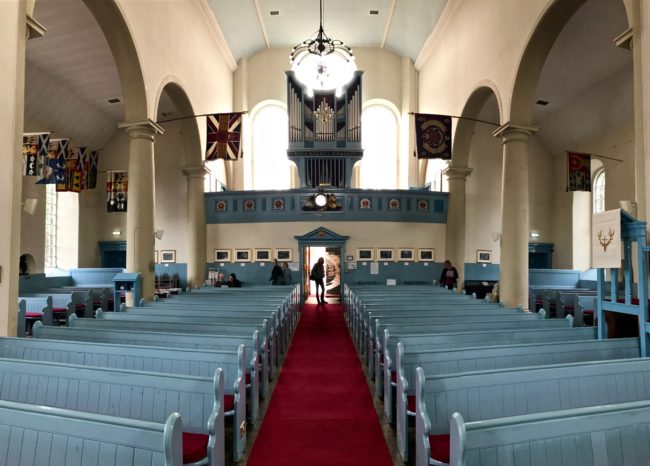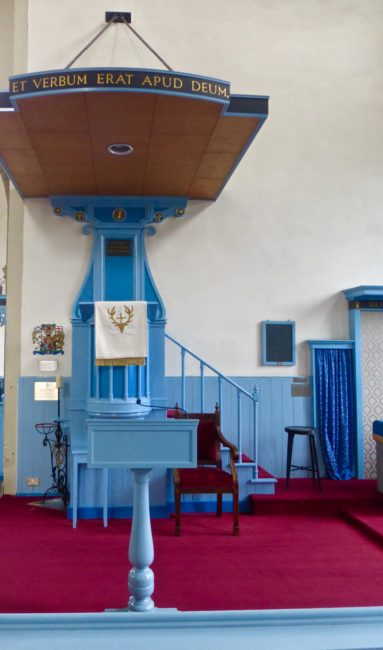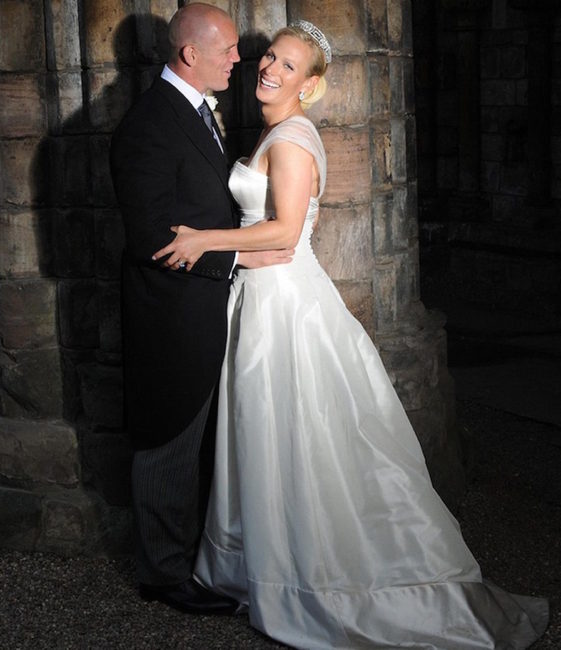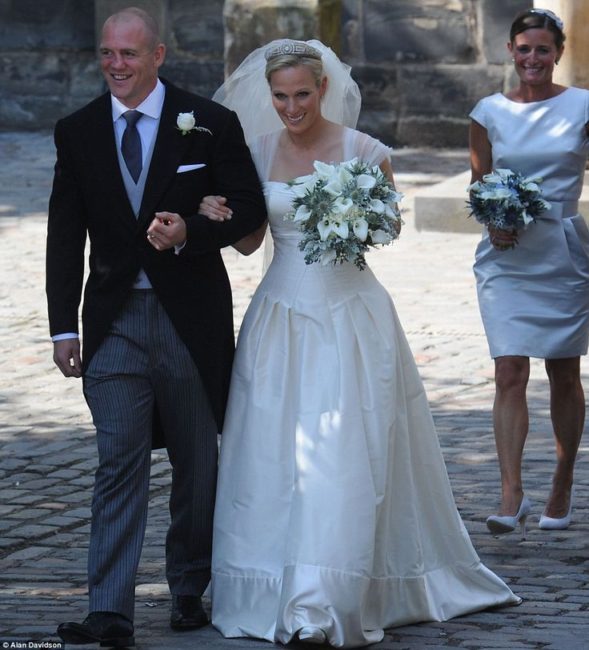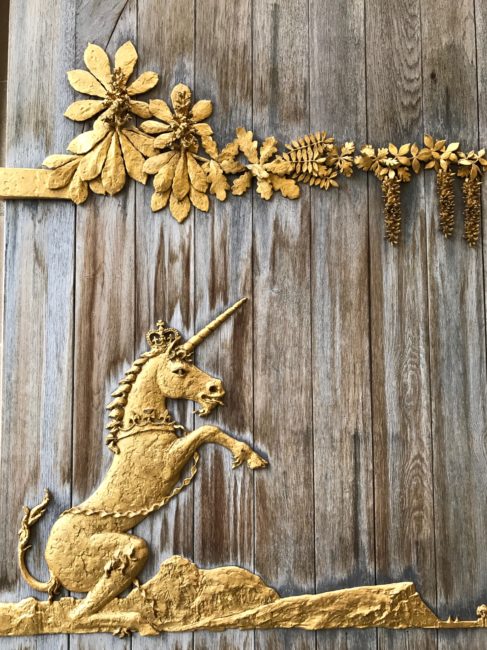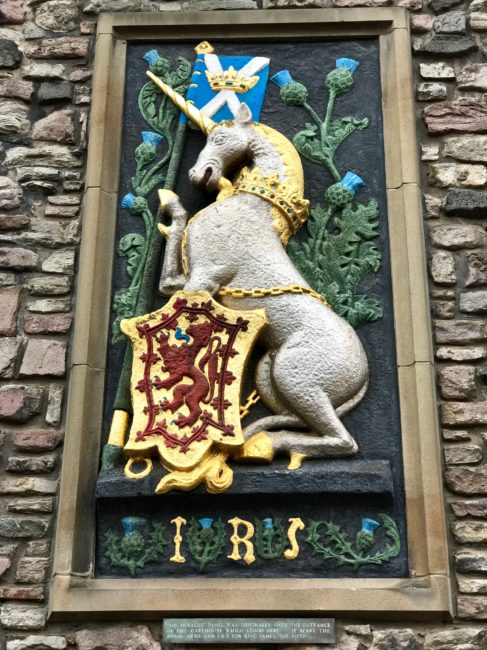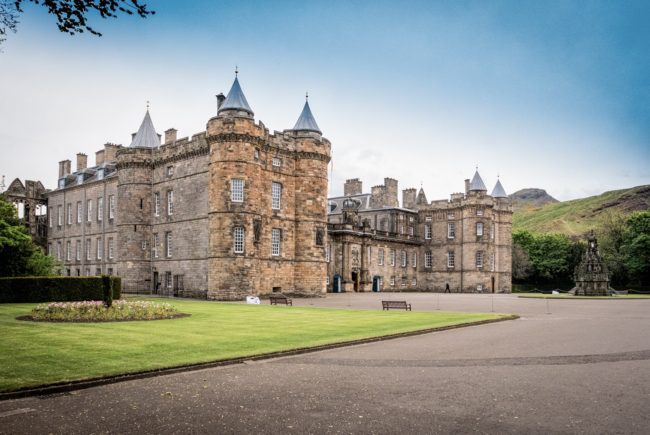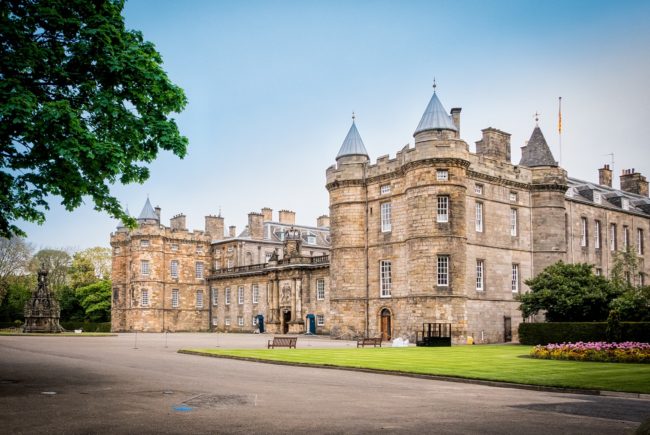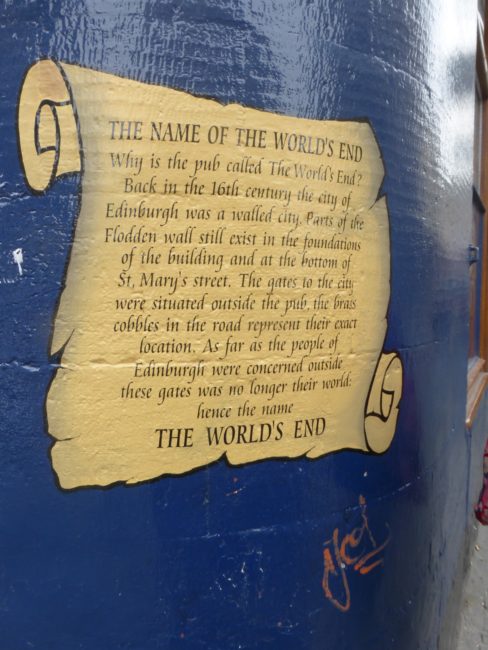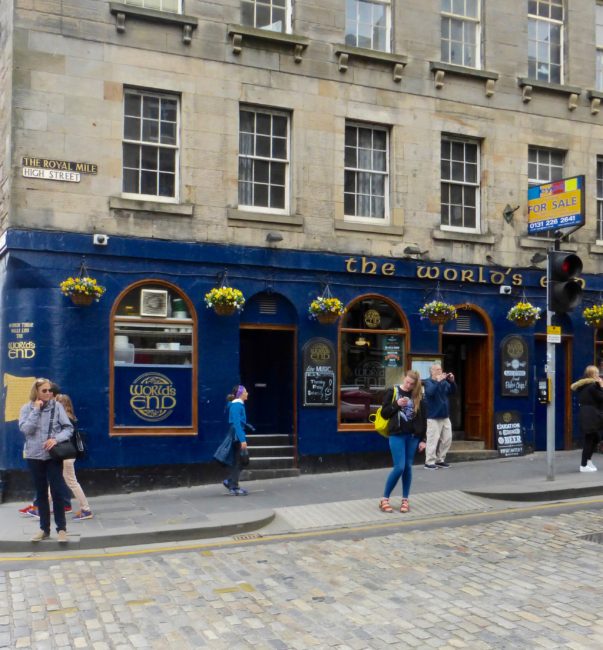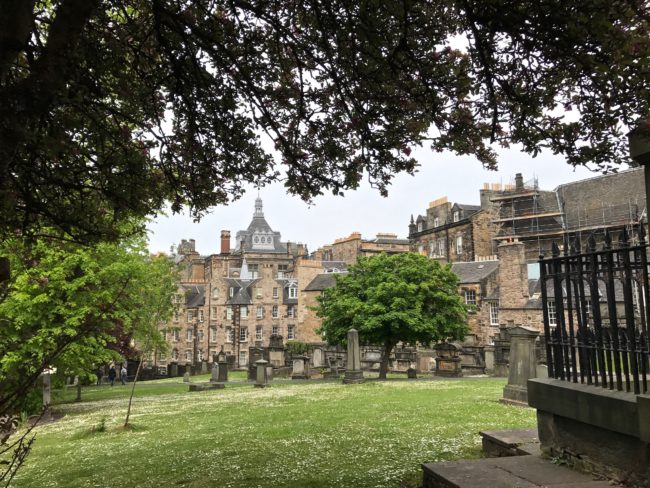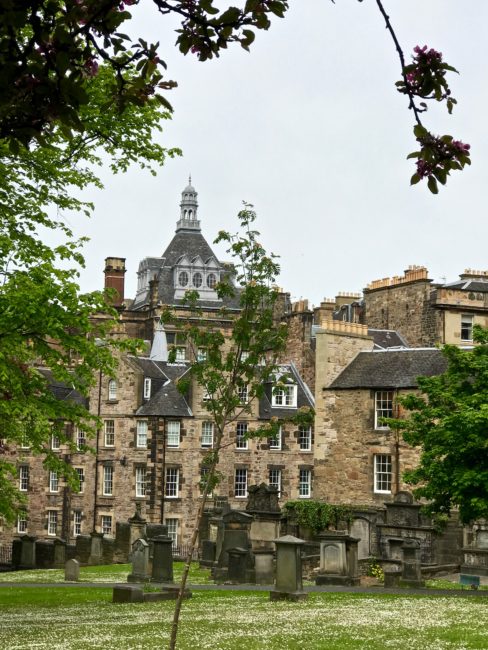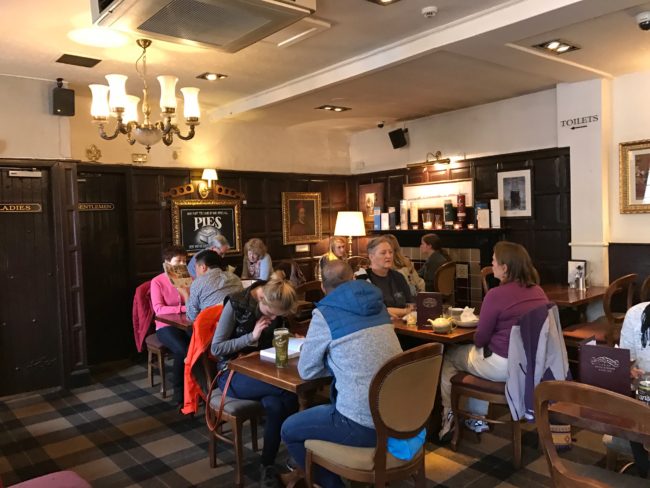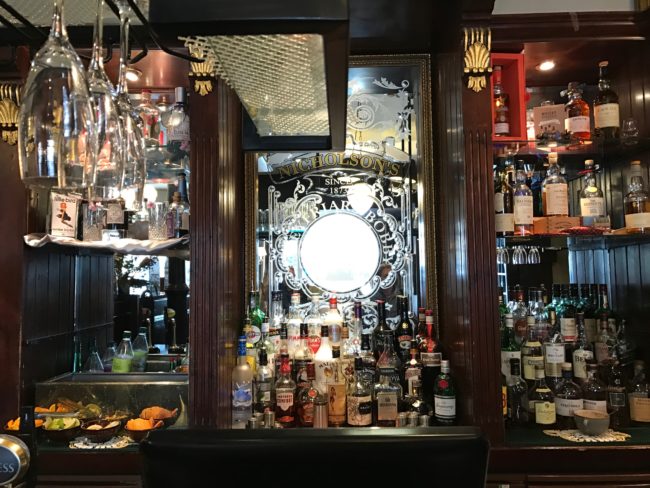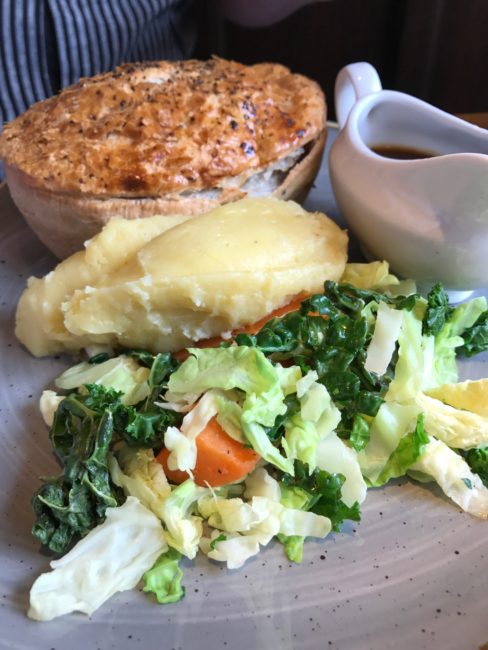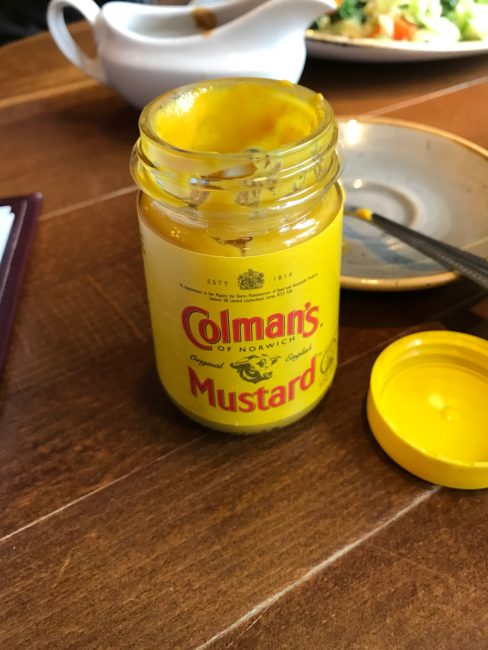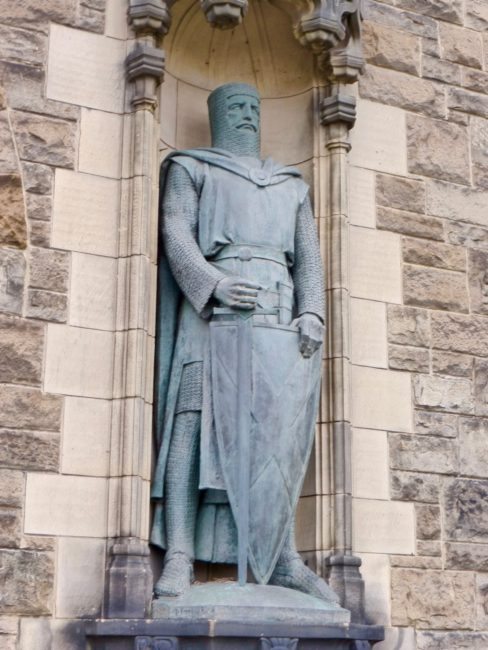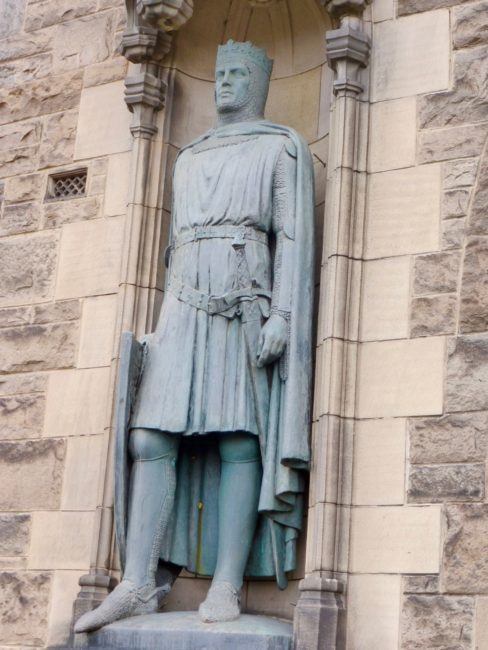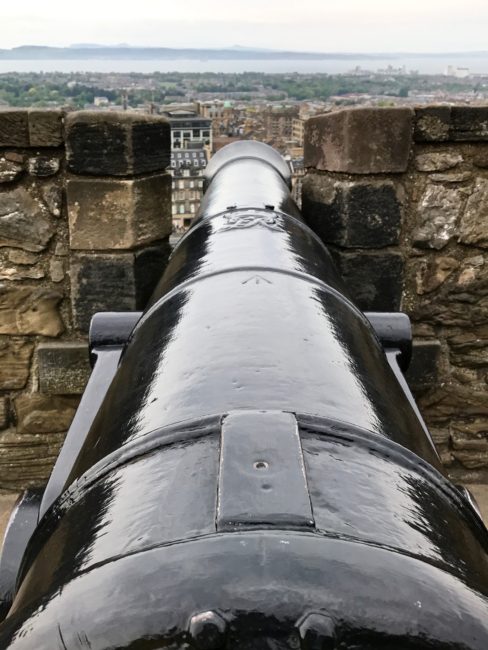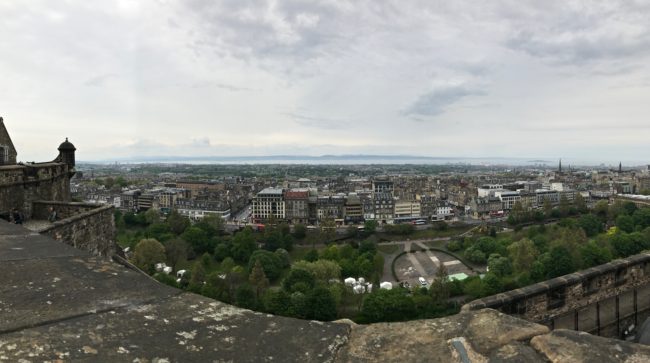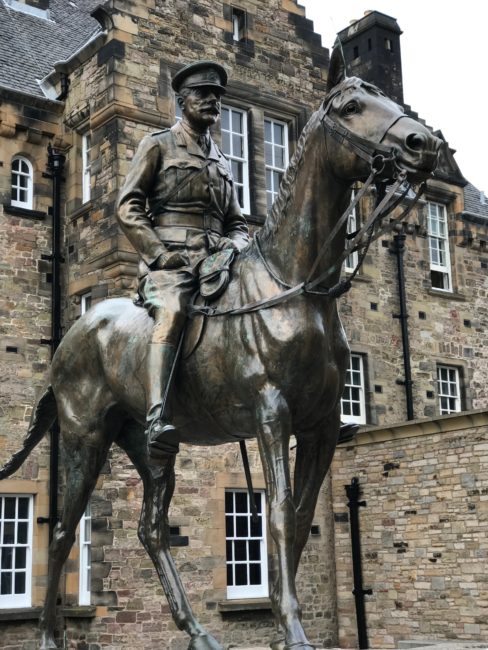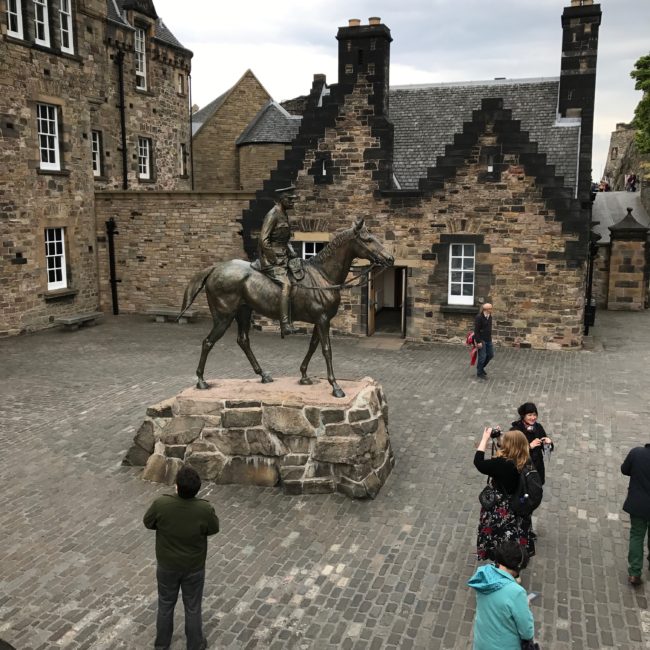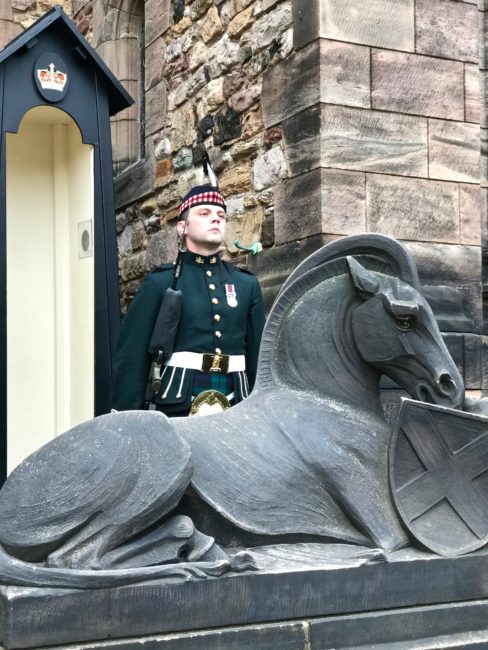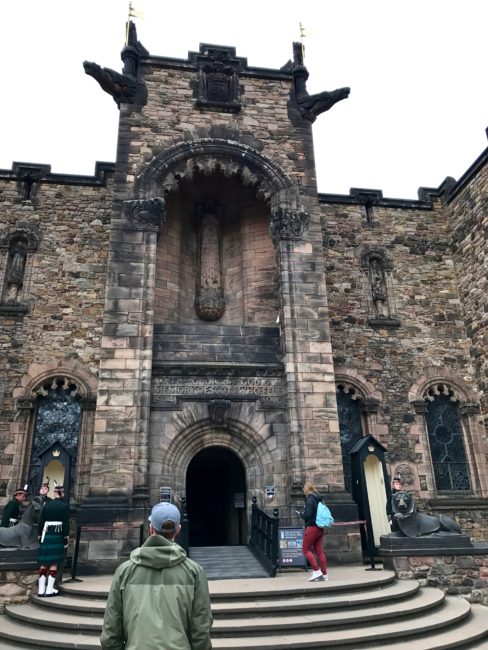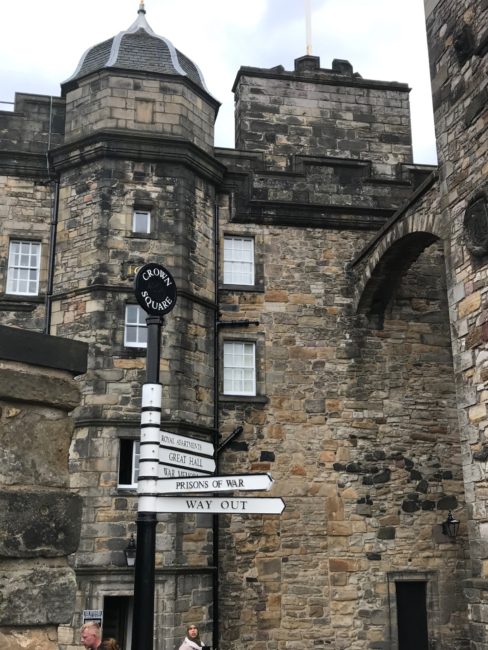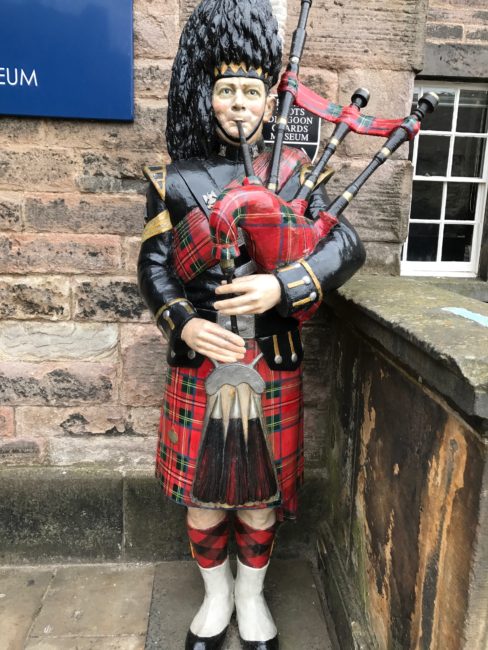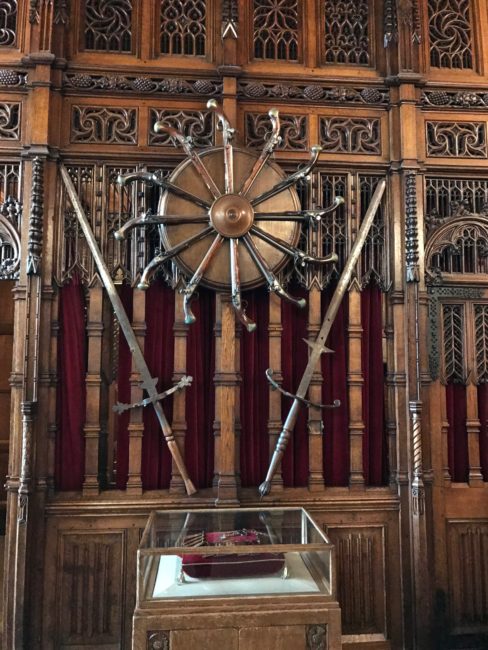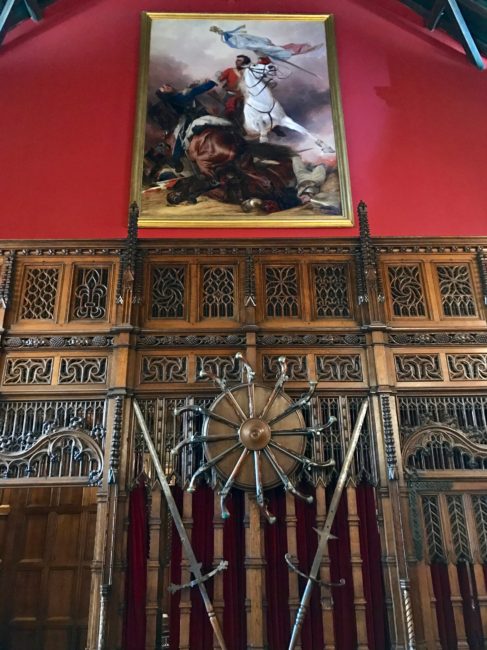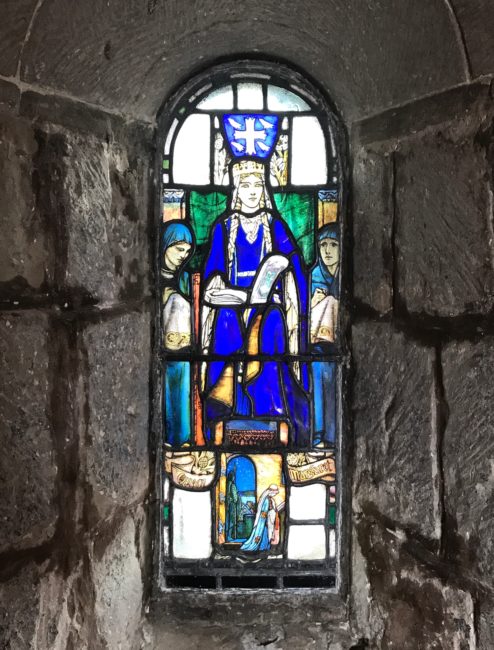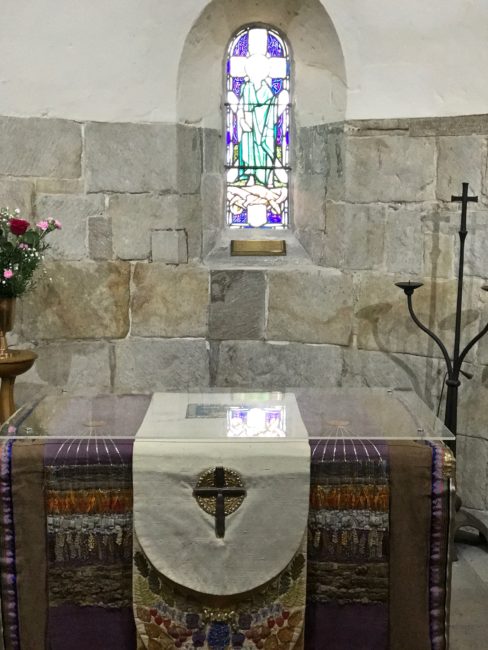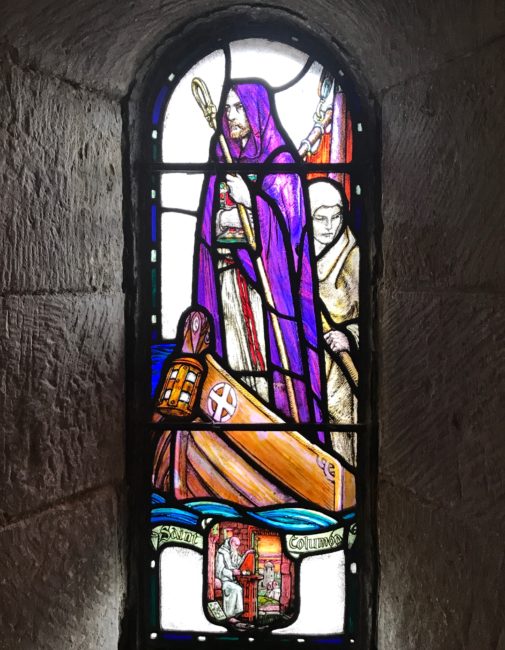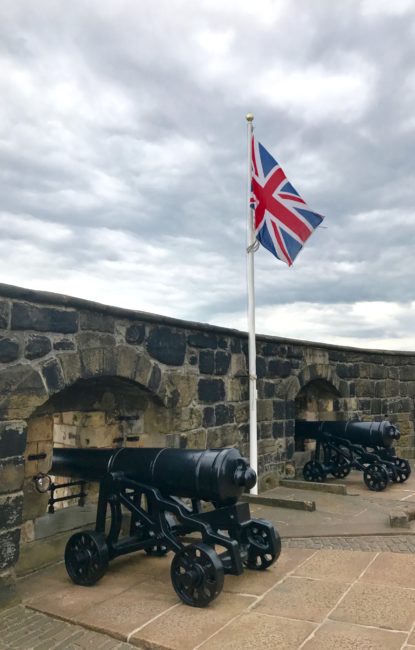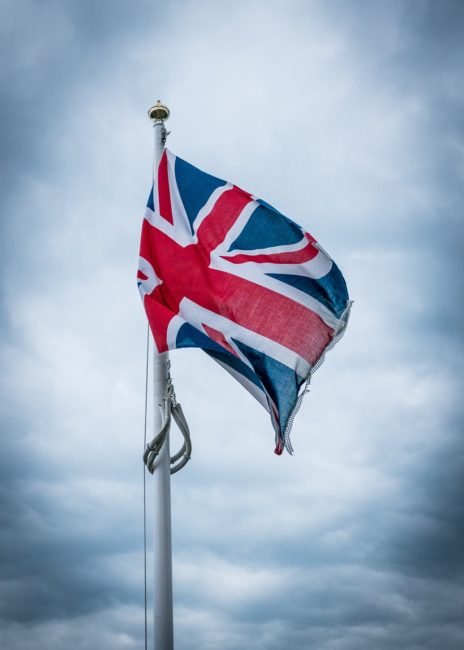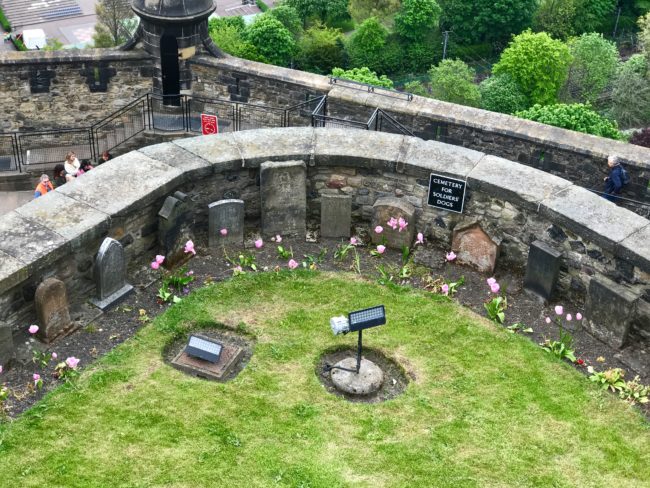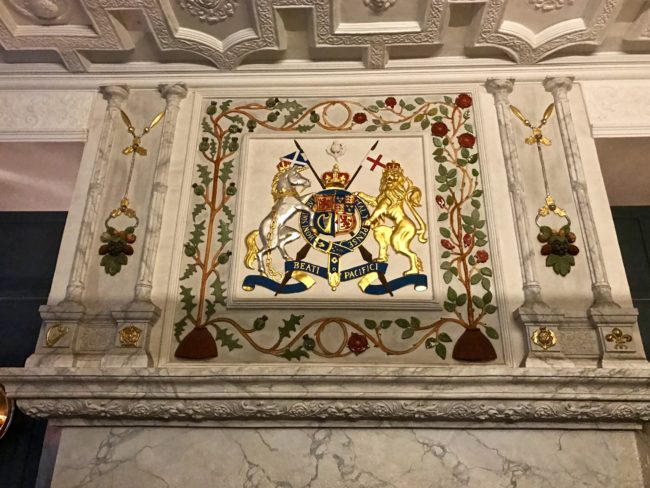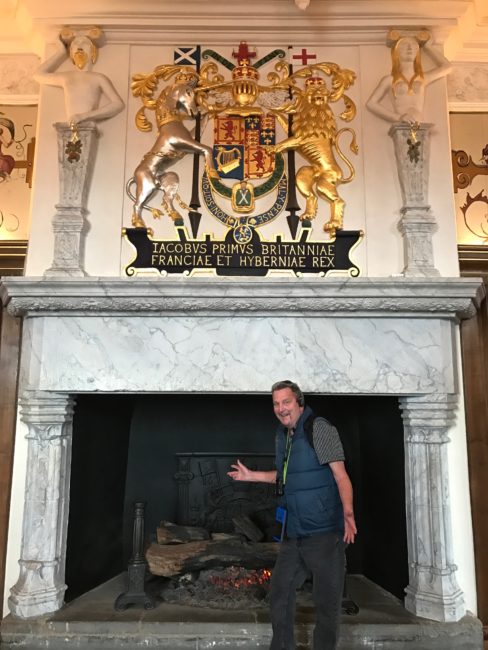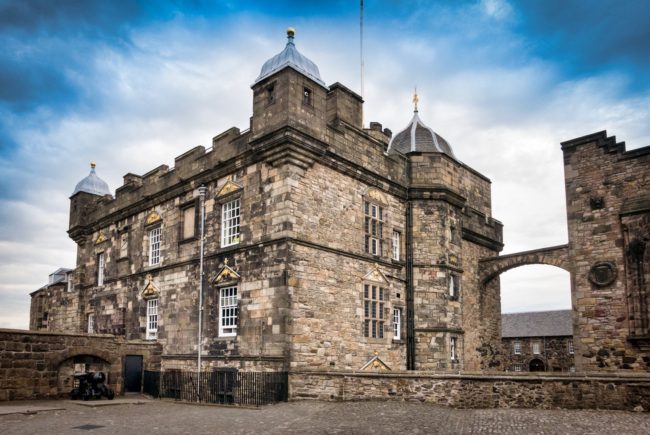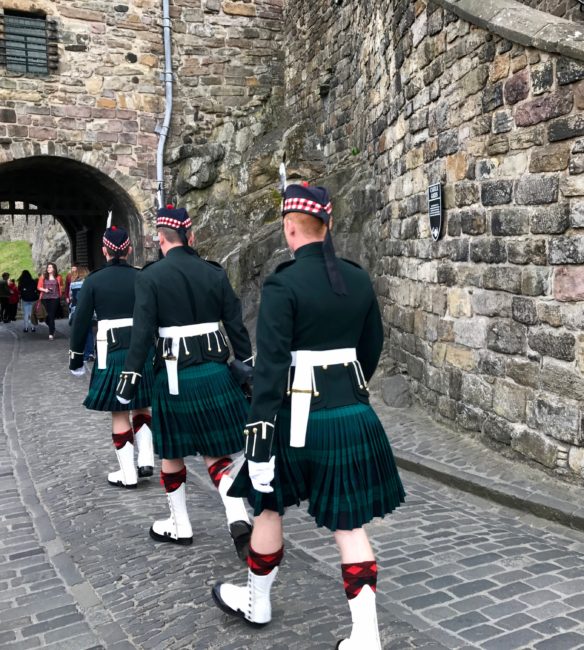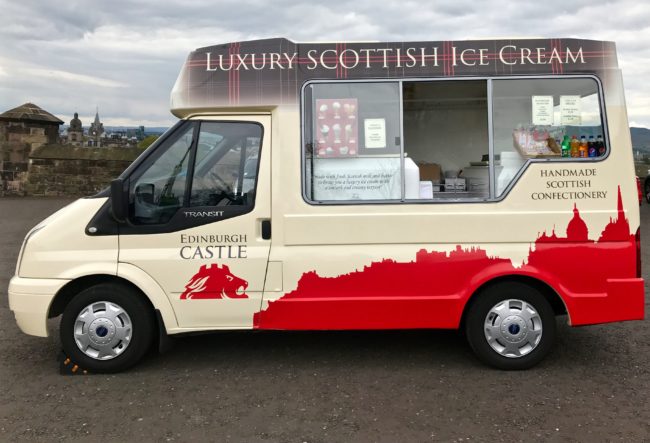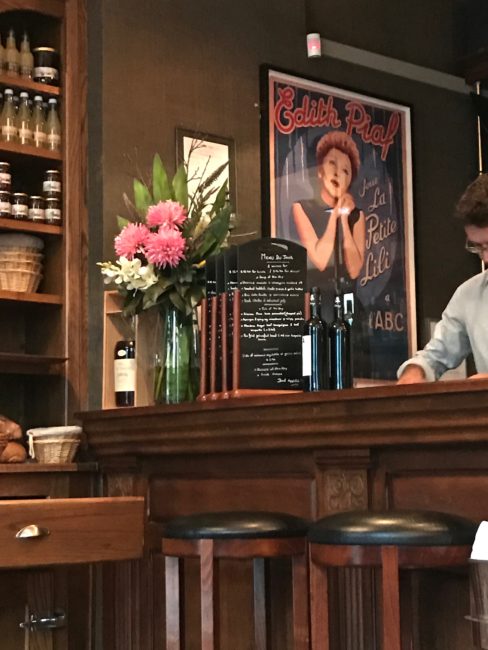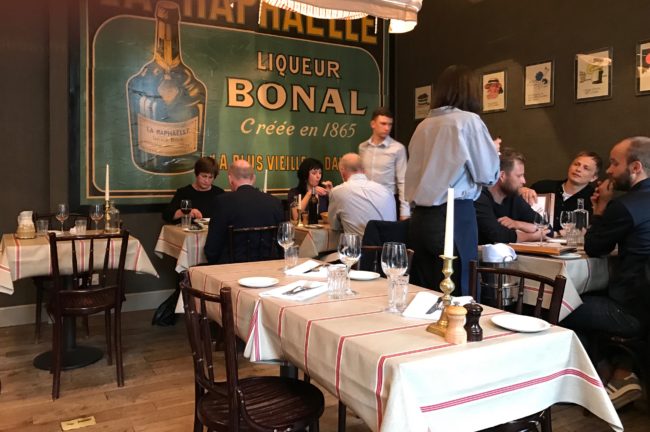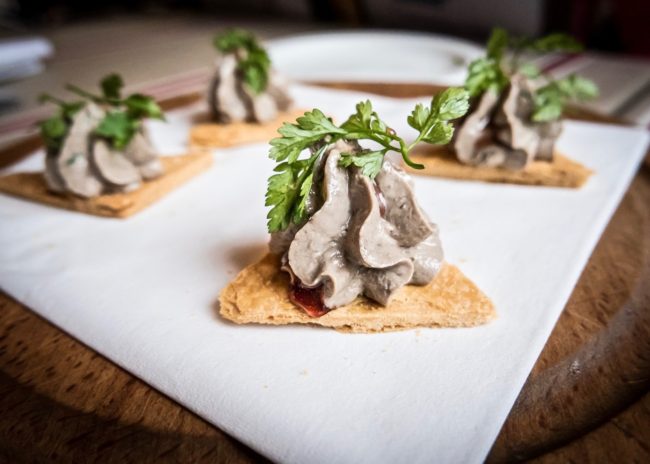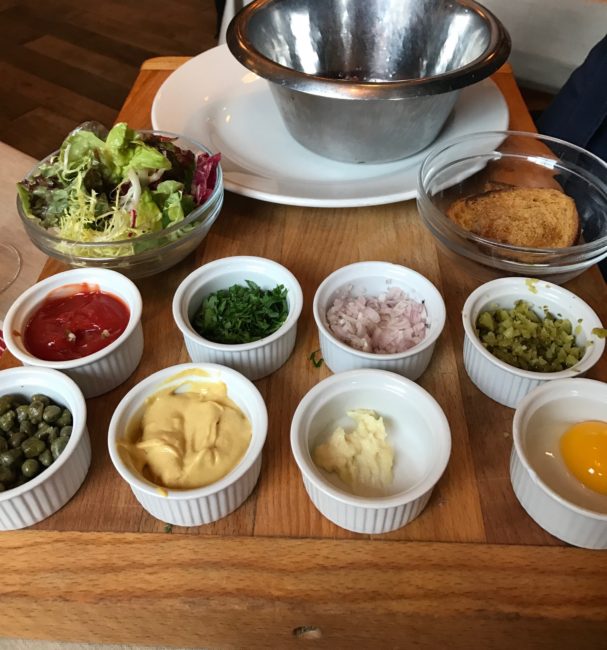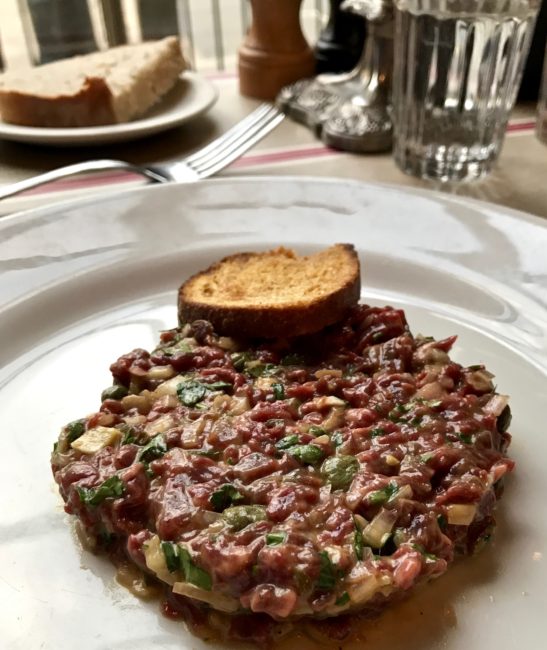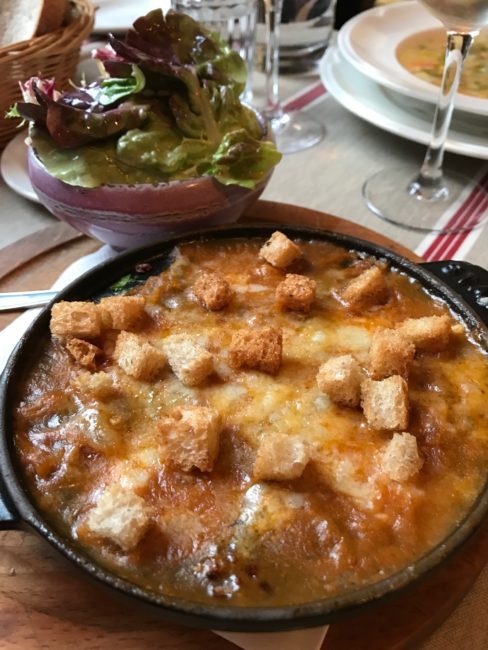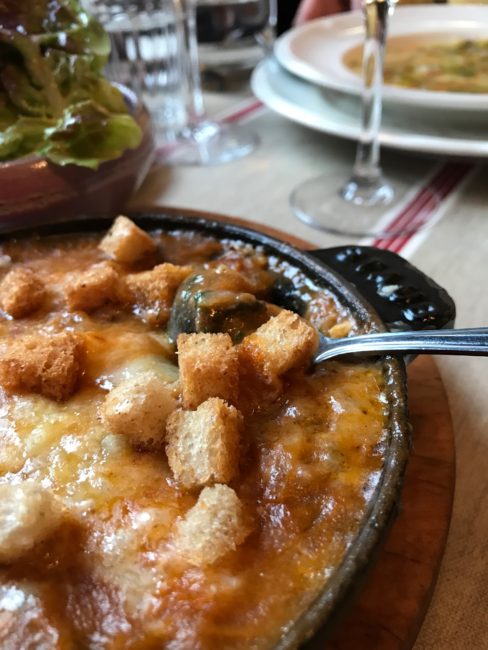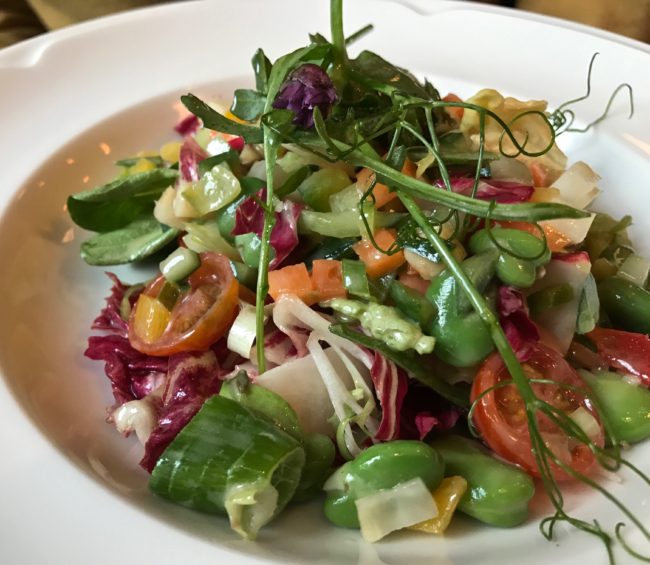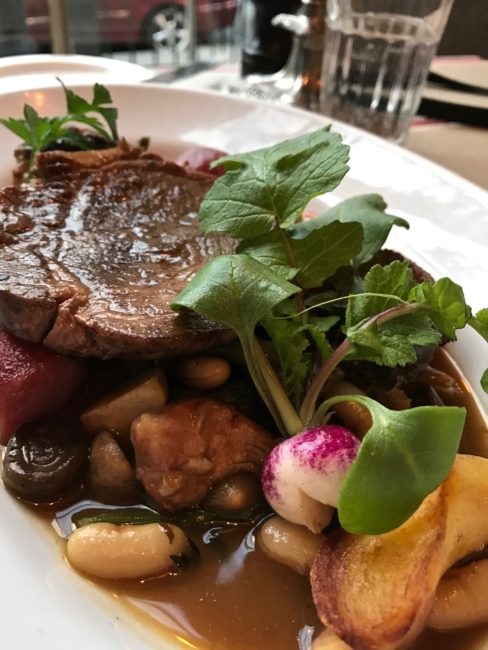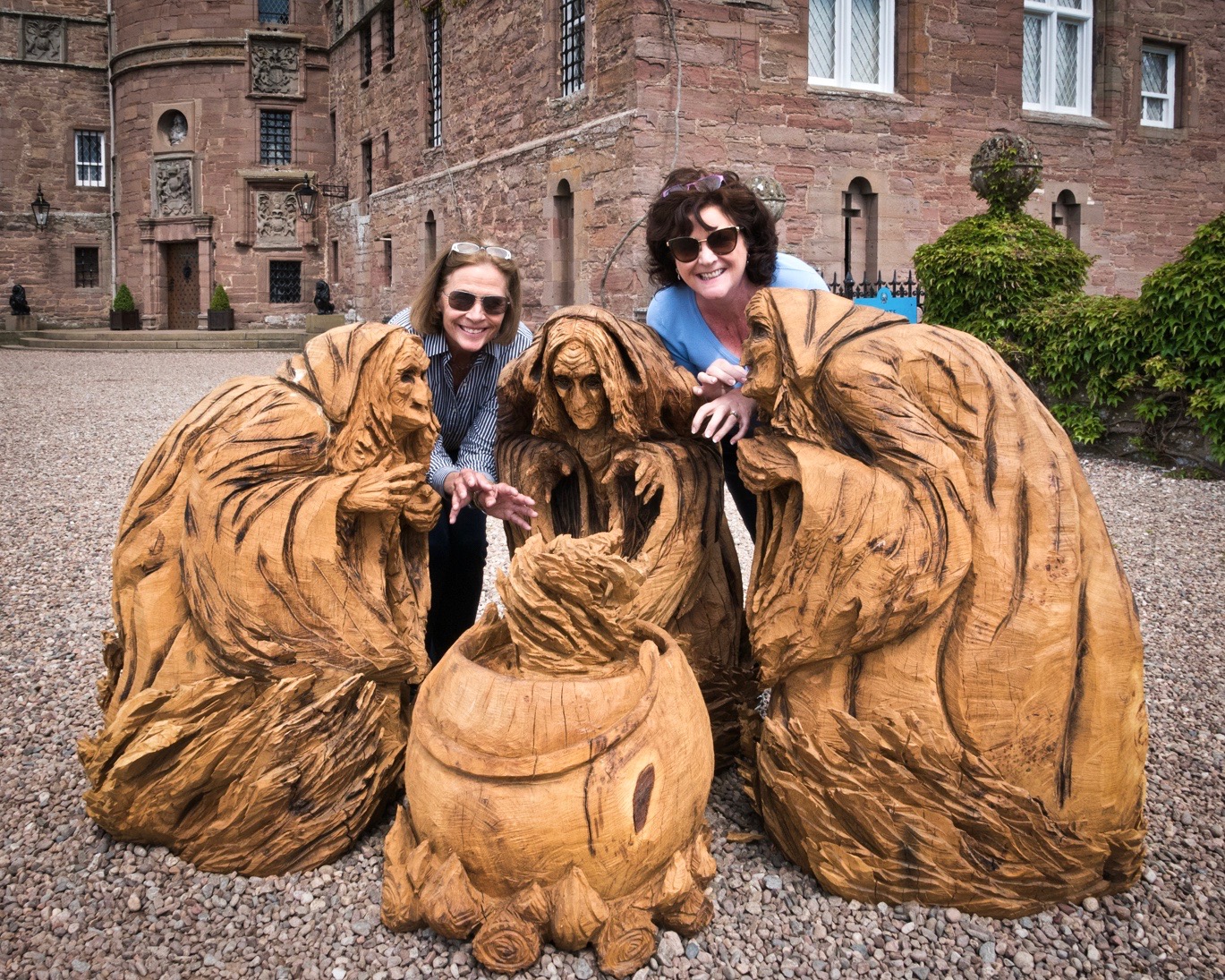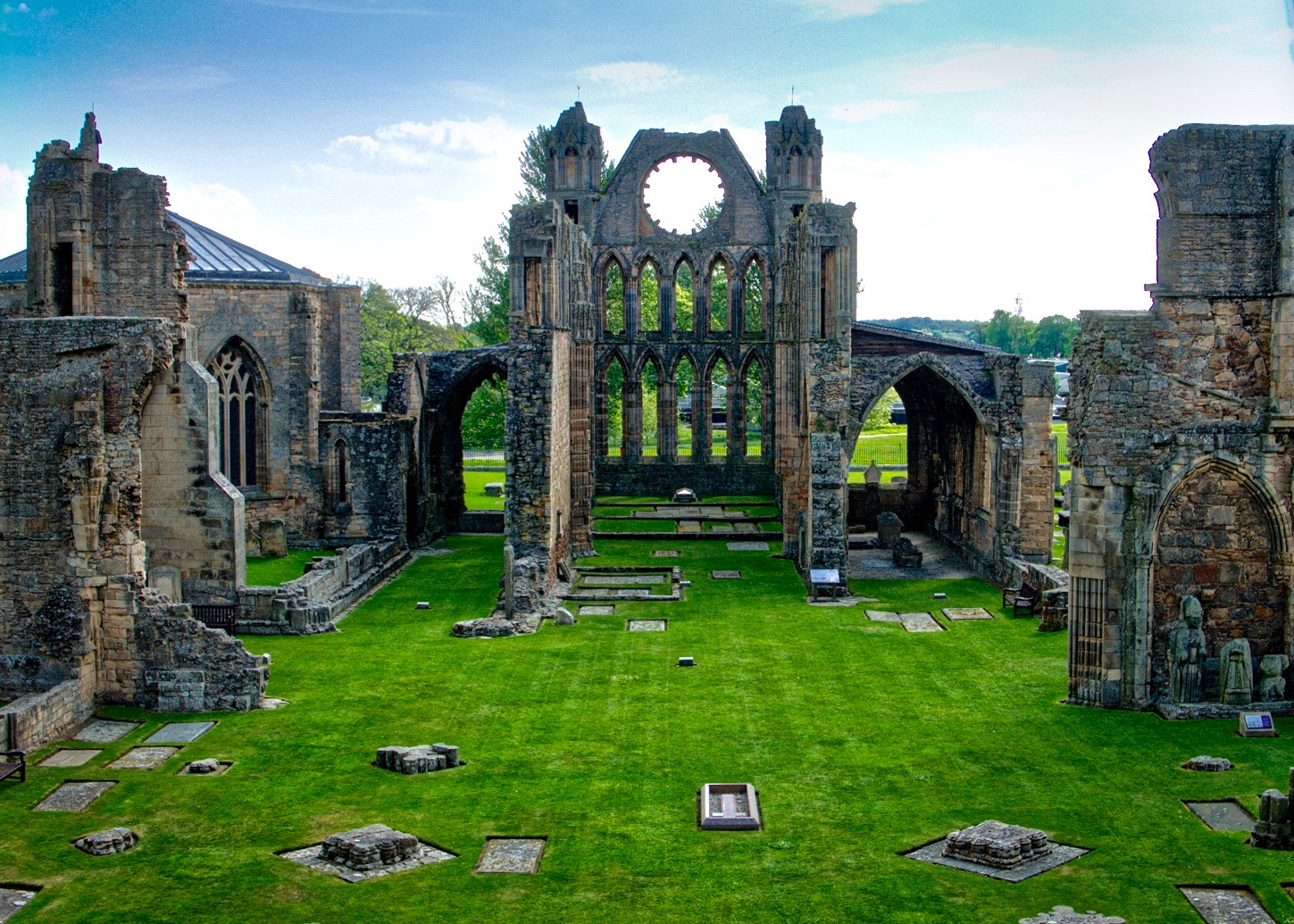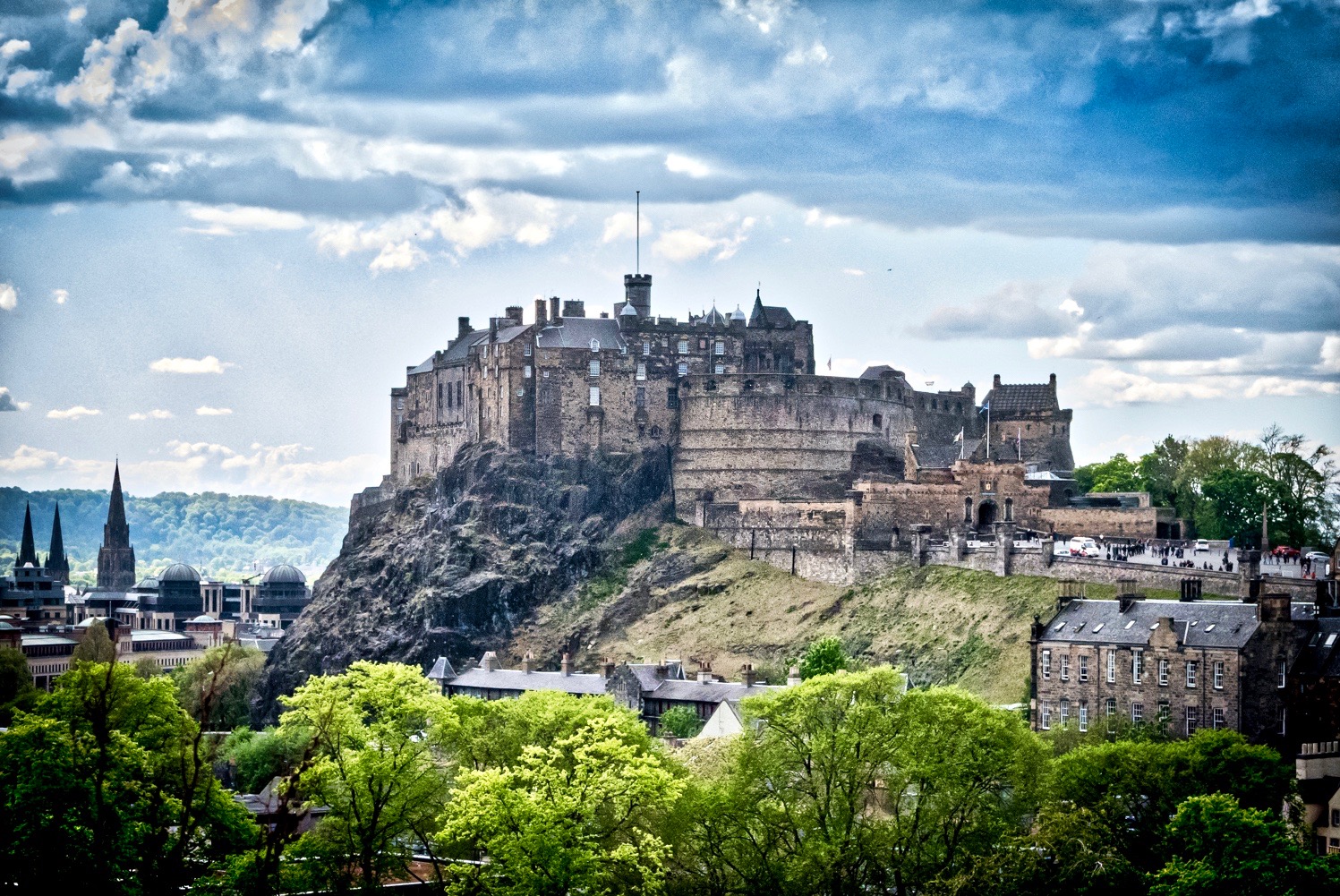
Chapter Four: Enchanting & Exciting Edinburgh
July 15, 2017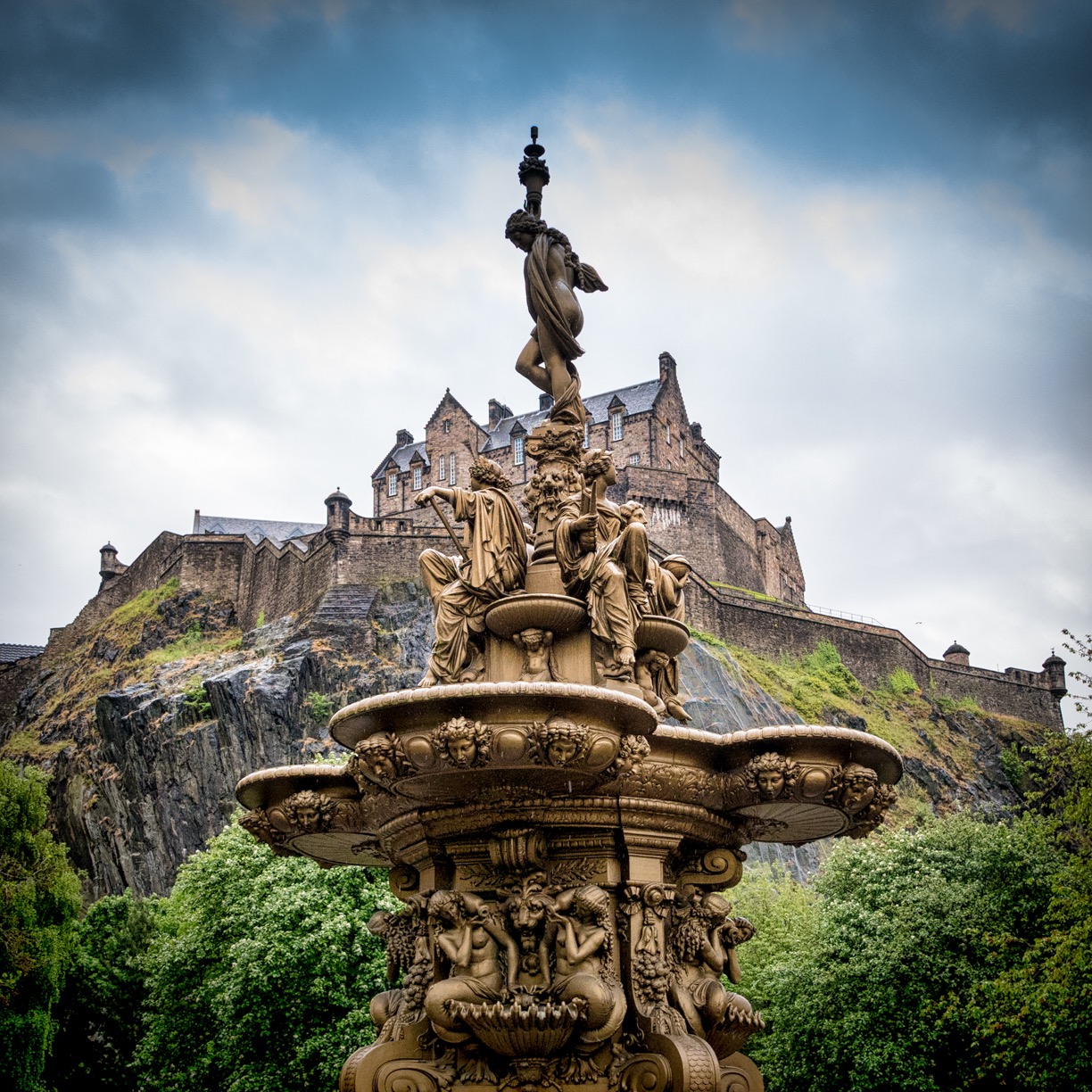
Chapter Six: Paintings, Princes, Peacocks, Pastries, Pubs & Afternoon Tea In Edinburgh
July 27, 2017MaiTaiTom Gets The Royal Treatment…Two Weeks Exploring London and Scotland
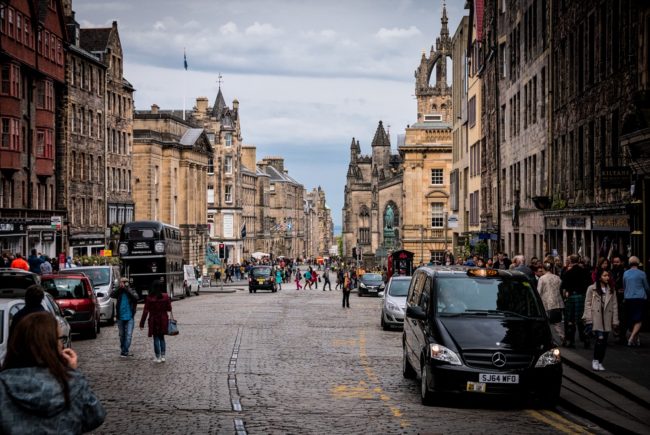 Chapter Five: Exploring Edinburgh’s Royal Mile
Chapter Five: Exploring Edinburgh’s Royal Mile
DAY SIX – Pass The Jam, Gorgeous Garden, Get Those Guards Outta Here, The Write Stuff, Is That Dr. Jekyll and Mr. Hyde, Cone Head, It’s In The Bagpipes, Close Encounters, Knox Knox It’s James’ House, How Much Do We Pay At The Tolbooth, Kirk But No Captain, Controversial Building, Anne Shuts Us Out, It’s The End Of The World As We Know It, Dedicated Dog, More Harry Potter, We Finally Make It In The Castle, The Giant Store and The Best Darned Steak Tartare Ever!
A little before 8:30 the four us, bolstered by a good night’s rest, met in Louise’s dining room. Kim, Mary and Tracy went for the full Scottish breakfast, complete with eggs, tomato, mushrooms, Canadian (Scottish) bacon and a banger.
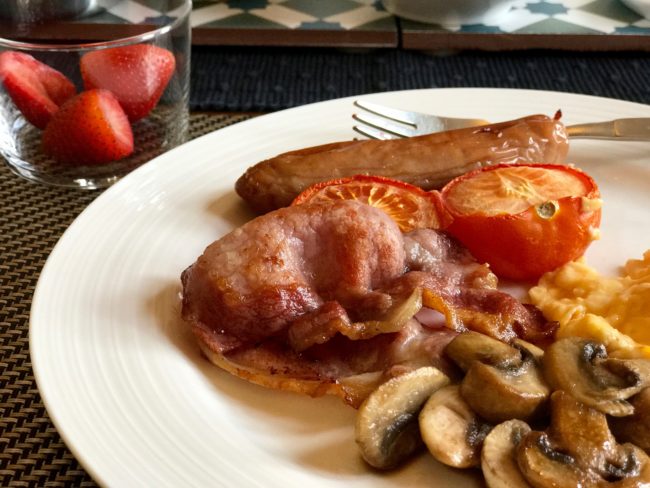 I, on the other hand, devoured a great French toast with strawberry jam. Speaking of jam, we all really enjoyed the toast with Mum’s homemade raspberry jam and orange/lemon marmalade. Wow! We loved it so much that both Mary and Tracy asked for the recipe, and Tracy is ready to fatten me up with some soon.
I, on the other hand, devoured a great French toast with strawberry jam. Speaking of jam, we all really enjoyed the toast with Mum’s homemade raspberry jam and orange/lemon marmalade. Wow! We loved it so much that both Mary and Tracy asked for the recipe, and Tracy is ready to fatten me up with some soon.
Admiring Mum’s garden and lovely flowers…
…we reluctantly told Louise about our Tuesday night escapades in London and that we had made dinner reservations for the “Reverend” and his guests on Saturday night at Prestonfield House. Louise said Prestonfield House is a gorgeous property, but she suggested we might want to go for tea instead so as to not further endanger our already rapidly dwindling bank accounts. She changed our reservations to Saturday afternoon.
We took a taxi to Edinburgh Castle where our day ostensibly was to begin. It was about 10 a.m., and the castle was surrounded (sorta like the olden days) by massive throngs of people. Nobody could get in. Although I read that the “Changing of the Guard” usually takes place at 11 a.m., it seems they were an hour early on this day (must be that darned daylight saving time).
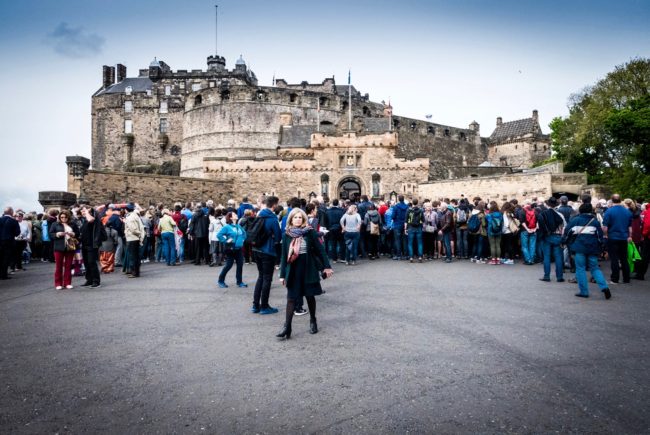 We decided to save the castle for later in the day and down the Royal Mile we walked (which I believe was the only time we walked downhill in Edinburgh). We spotted the Castle Wynd Steps that takes you to the Grassmarket, which we would visit the following evening.
We decided to save the castle for later in the day and down the Royal Mile we walked (which I believe was the only time we walked downhill in Edinburgh). We spotted the Castle Wynd Steps that takes you to the Grassmarket, which we would visit the following evening.
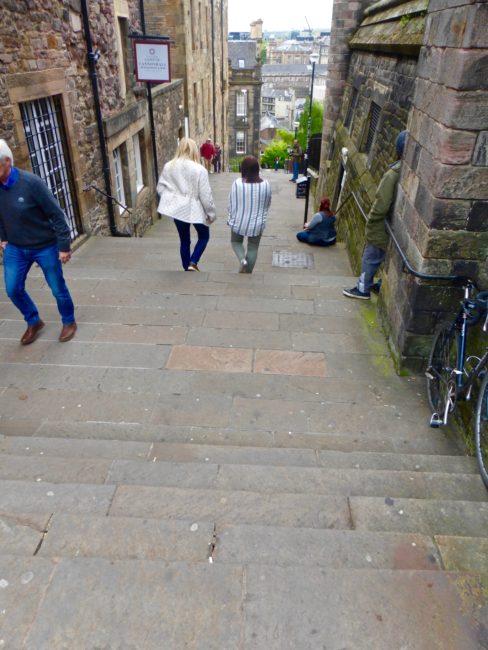 We admired the Tolbooth Kirk (photo taken by Kim the previous night after dinner) and its octagonal spire (the tallest in Edinburgh).
We admired the Tolbooth Kirk (photo taken by Kim the previous night after dinner) and its octagonal spire (the tallest in Edinburgh).
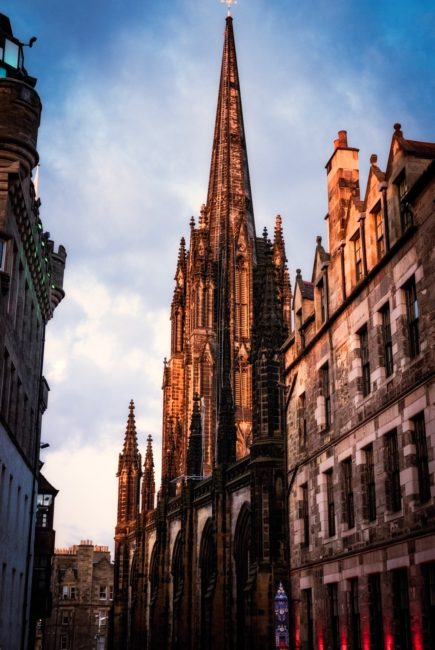 It hasn’t been a Kirk since 1984, the same year Captain Kirk initiated The Search For Spock (coincidence, I think not).
It hasn’t been a Kirk since 1984, the same year Captain Kirk initiated The Search For Spock (coincidence, I think not).
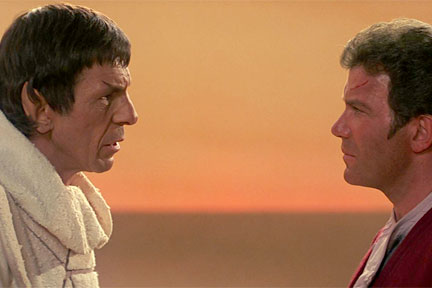 Leaving Castle Hill, our stroll took us to Lawnmarket, which is the oldest part of the Old Town.
Leaving Castle Hill, our stroll took us to Lawnmarket, which is the oldest part of the Old Town.
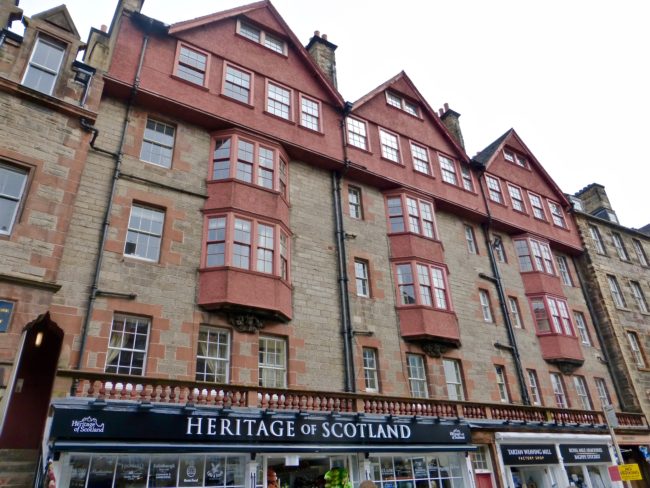 Just off the Lawnmarket is The Writer’s Museum, which was built in 1622 by Sir William Gray. The house was gifted to the city as a museum in 1907. The Writer’s Museum is free and was a nice diversion, especially if you’re interested in Scottish authors. They do have tours, and since this museum highlights authors, it helps to book your tour at what is now known as Lady Stair’s House, which is accessed by the Lady Stair’s Close.
Just off the Lawnmarket is The Writer’s Museum, which was built in 1622 by Sir William Gray. The house was gifted to the city as a museum in 1907. The Writer’s Museum is free and was a nice diversion, especially if you’re interested in Scottish authors. They do have tours, and since this museum highlights authors, it helps to book your tour at what is now known as Lady Stair’s House, which is accessed by the Lady Stair’s Close.
In 1719, Elizabeth, Dowager Countess of Stair, bought the building and so the close and house took on her name…and here I thought she was Lady Stairs because she was a step daughter.
Robert Burns, Sir Walter Scott and Robert Louis Stevenson are celebrated here, including busts of the three. These guys had the “write stuff” alright.
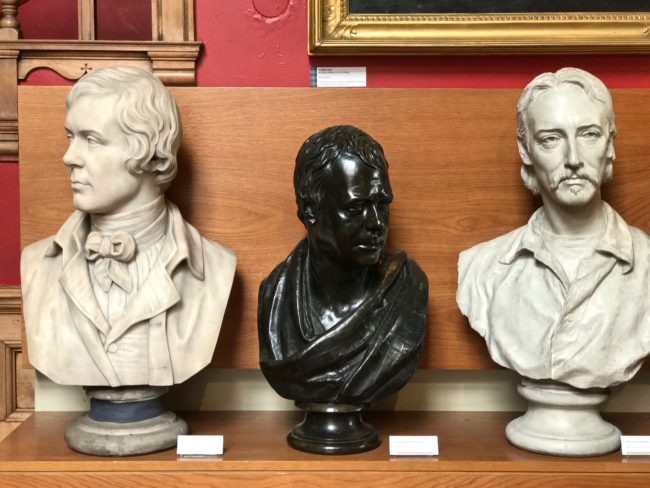 This colorful room is dedicated to Burns.
This colorful room is dedicated to Burns.
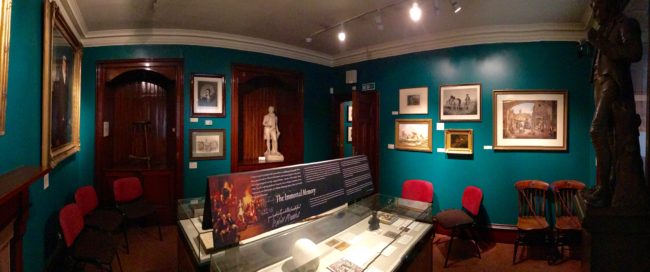 We considered taking a tour of Gladstone’s Land, a 500-year-old building that offers tours recounting tenement life in Edinburgh’s Old Town, but didn’t know if we’d have time for it, Holyrood Palace and the castle. The building was once owned by merchant Thomas Gladstone. We never ended up taking that tour, but we ran into a couple of interesting creatures there a couple of days later.
We considered taking a tour of Gladstone’s Land, a 500-year-old building that offers tours recounting tenement life in Edinburgh’s Old Town, but didn’t know if we’d have time for it, Holyrood Palace and the castle. The building was once owned by merchant Thomas Gladstone. We never ended up taking that tour, but we ran into a couple of interesting creatures there a couple of days later.
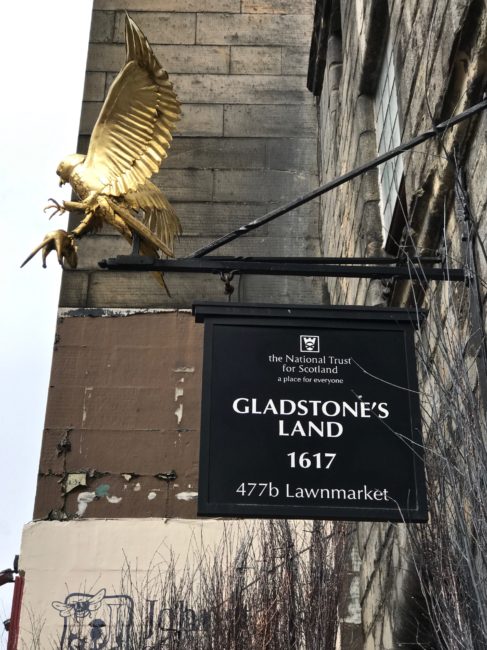 At Wardrop’s Court, Tracy liked this photo op of one of its two dragons, who we affectionately dubbed Puff.
At Wardrop’s Court, Tracy liked this photo op of one of its two dragons, who we affectionately dubbed Puff.
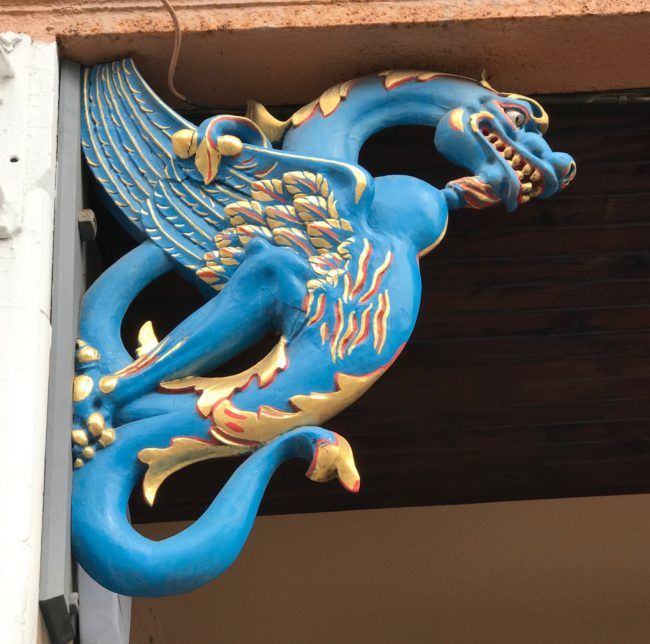 It was a busy morning on the Royal Mile.
It was a busy morning on the Royal Mile.
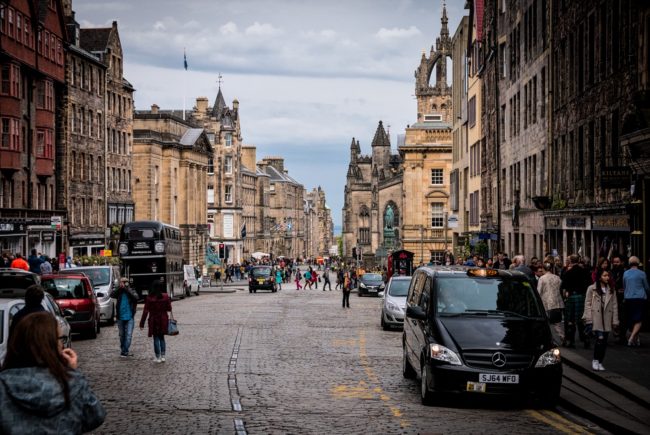 We found ourselves in front of Deacon Brodie’s Tavern at the corner of Lawnmarket and Bank Street. It seems William Brodie was a Deacon Councillor of Edinburgh who also possessed a dark side. “By day he was an outwardly respectable citizen and pillar of society, but by night ‘he was a gambler, a thief, dissipated and licentious.‘ To support his lavish lifestyle, Brodie would copy the keys of his wealthy clients and return at night to rob them. He escaped to Amsterdam in the Netherlands after being recognized at the scene of one of his crimes only to be caught and returned to Scotland. He was hanged from the city’s new gallows at the Tolbooth (which ironically it is said he had a hand in designing) on 1 October, 1788.” Brodie served as the inspiration for Robert Louis Stevenson’s classic, “The Strange Case of Dr Jekyll and Mr Hyde.”
We found ourselves in front of Deacon Brodie’s Tavern at the corner of Lawnmarket and Bank Street. It seems William Brodie was a Deacon Councillor of Edinburgh who also possessed a dark side. “By day he was an outwardly respectable citizen and pillar of society, but by night ‘he was a gambler, a thief, dissipated and licentious.‘ To support his lavish lifestyle, Brodie would copy the keys of his wealthy clients and return at night to rob them. He escaped to Amsterdam in the Netherlands after being recognized at the scene of one of his crimes only to be caught and returned to Scotland. He was hanged from the city’s new gallows at the Tolbooth (which ironically it is said he had a hand in designing) on 1 October, 1788.” Brodie served as the inspiration for Robert Louis Stevenson’s classic, “The Strange Case of Dr Jekyll and Mr Hyde.”
Lawnmarket now becomes High Street, and once again we ran into our old friend, the philosopher David Hume. It seems that sometime overnight a reveler got the crazy idea to put a construction cone on Hume’s head.
While he pondered his fate, we ran across the street and made a quick stop in St. Giles Cathedral again, paying homage to the Unicorn overhead.
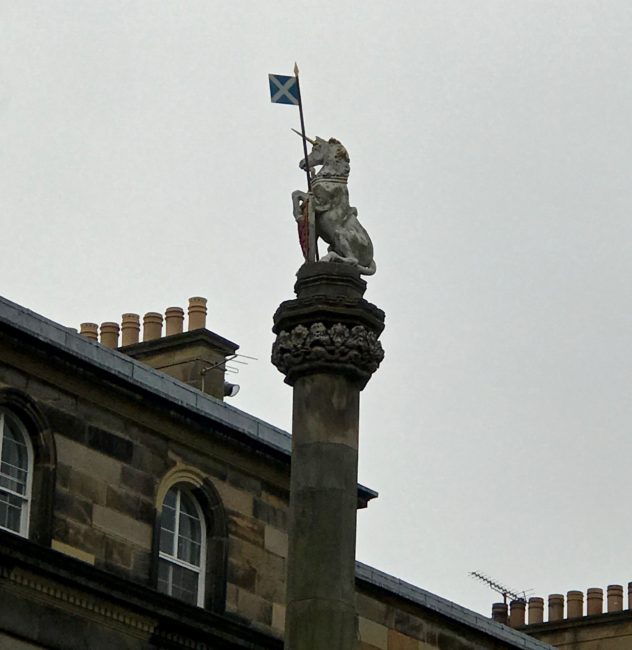 Inside, we saw one thing we’d missed the previous day, a memorial to a Scottish regiment that suffered heavy loss of life in India. All these deaths were not by battle, but by disease.
Inside, we saw one thing we’d missed the previous day, a memorial to a Scottish regiment that suffered heavy loss of life in India. All these deaths were not by battle, but by disease.
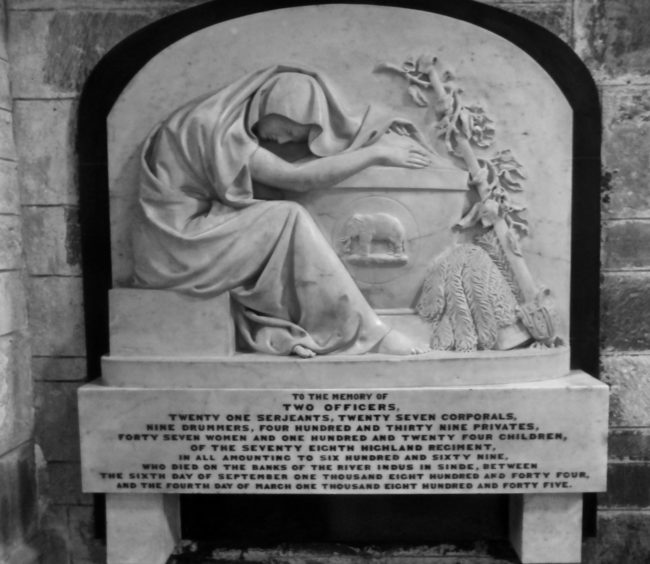 We got wind of a guy playing some music. He had good pipes. Don’t you just hate it when some idiot tourist has to interject themselves into a photo?
We got wind of a guy playing some music. He had good pipes. Don’t you just hate it when some idiot tourist has to interject themselves into a photo?
We decided to save The Real Mary King’s Close tour for another trip, because Kim and I had a place we wanted to visit recommended by a friend of mine. Before that, however, we walked by the John Knox House, supposedly the one time home of the reformation preacher.
The Paisley Close has a tragic backstory. “In the early hours of November 24, 1861, 35 people were killed when a five story tenement, whose timber supports had become rotten, collapsed. In the frenzy of trying to rescue those trapped, the workers heard the repeated cry of a young boy from under the rubble saying. ‘Heave awa men, I’m no deid yet.’ Joseph McIver was rescued without major injury.” The lintel on Paisley Close is inscribed with McIvor’s cry for assistance.
I believe this could have been where Monty Python got the idea for the famed, “I’m not dead” scene, although I didn’t see any wheelbarrows in the vicinity.
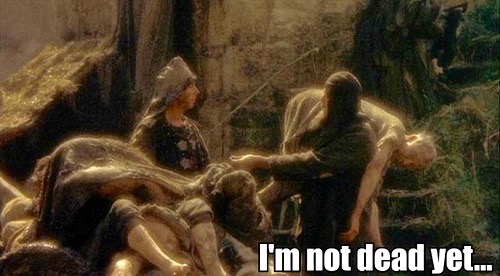 Tracy said she’d like to see me in these. I told her we didn’t have enough time to“kilt” while they were being made.
Tracy said she’d like to see me in these. I told her we didn’t have enough time to“kilt” while they were being made.
After walking by a couple of shops that made me hungry (hey, isn’t that Mary?)…
…we stopped by an establishment my friend Andy told me about before I left. He said that when we walked the Royal Mile to be sure to stop into a certain whisky shop. When Andy talks booze…people listen. At 172 Canongate (the Royal Mile changes names more often than Sean Combs)…
 …stands Cadenhead’s Whisky Shop. Tracy wrote in her notes “we stumbled upon it,” however the only stumbling was done by Kim and myself after tasting 110 proof whisky at 11:15 in the morning.
…stands Cadenhead’s Whisky Shop. Tracy wrote in her notes “we stumbled upon it,” however the only stumbling was done by Kim and myself after tasting 110 proof whisky at 11:15 in the morning.
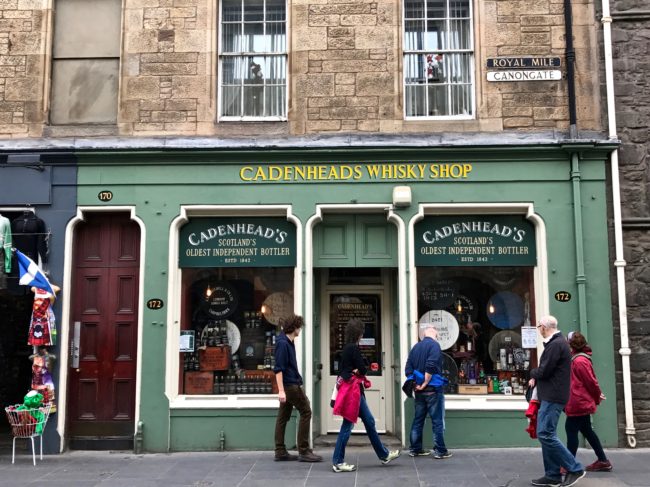 Truthfully, we were treated to an expert and enlightening course in Whisky 101 at Cadenhead’s, which purports to be the oldest independent bottler in Scotland (1842). We were shown and told about our choices…
Truthfully, we were treated to an expert and enlightening course in Whisky 101 at Cadenhead’s, which purports to be the oldest independent bottler in Scotland (1842). We were shown and told about our choices…
…Kim and I listened intently (Kim a little more intently)…
…and then we took a few sips. Sufficiently lubricated, we purchased a couple of bottles and we were back on our walk.
Looming ahead was the Canongate Tolbooth, constructed in 1591 and served as the municipal building, court and prison for the Burgh of Canongate.
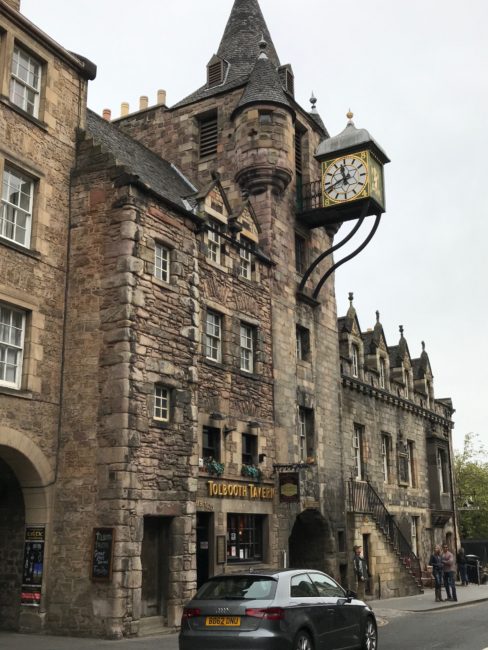 Now it was time to go to church. Canongate Kirk was designed by James Smith and completed in 1691.
Now it was time to go to church. Canongate Kirk was designed by James Smith and completed in 1691.
Our docent related that the church was formerly very dark, so they decided to brighten it up with the blue pews.
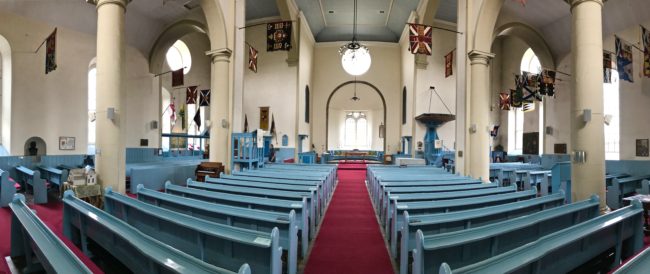 They also moved the organ upstairs.
They also moved the organ upstairs.
The docent also informed us that Zara Tindall Phillips, the only daughter of Princess Anne, was married here in 2011. We were told it was quite a scene as the guests walked to the reception at Holyrood Palace with more than 5,000 people looking on (Queen Elizabeth and Prince Philip, along with Charles and Camilla, took a car).
There is a war memorial in the church, as well.
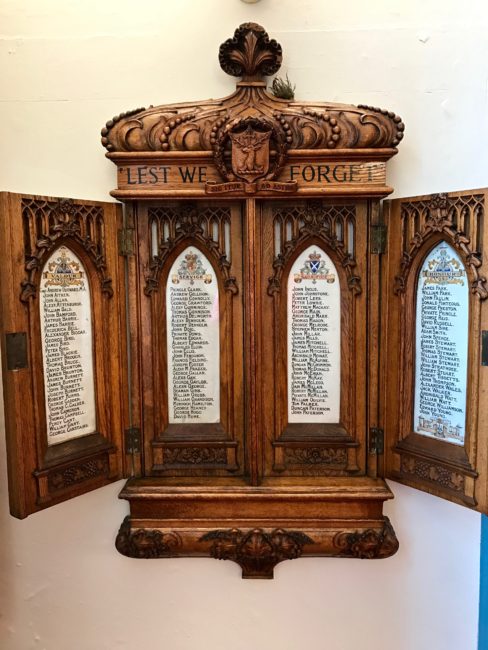 After touring the church, we walked for a few minutes in the Canongate Kirkyard.
After touring the church, we walked for a few minutes in the Canongate Kirkyard.
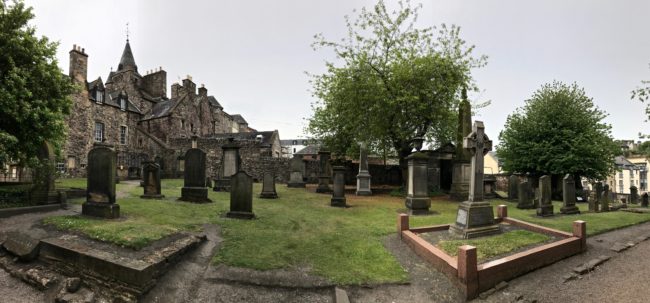 Back outside, we saw a statue of a man walking in front of the church. Scot poet Robert Fergusson was a huge influence on Robert Burns. Fergusson was killed from a fall and passed away at only 24 years of age. Burns paid for a headstone to be erected to Fergusson, who had already been buried in the cemetery. This is Fergusson’s statue in front.
Back outside, we saw a statue of a man walking in front of the church. Scot poet Robert Fergusson was a huge influence on Robert Burns. Fergusson was killed from a fall and passed away at only 24 years of age. Burns paid for a headstone to be erected to Fergusson, who had already been buried in the cemetery. This is Fergusson’s statue in front.
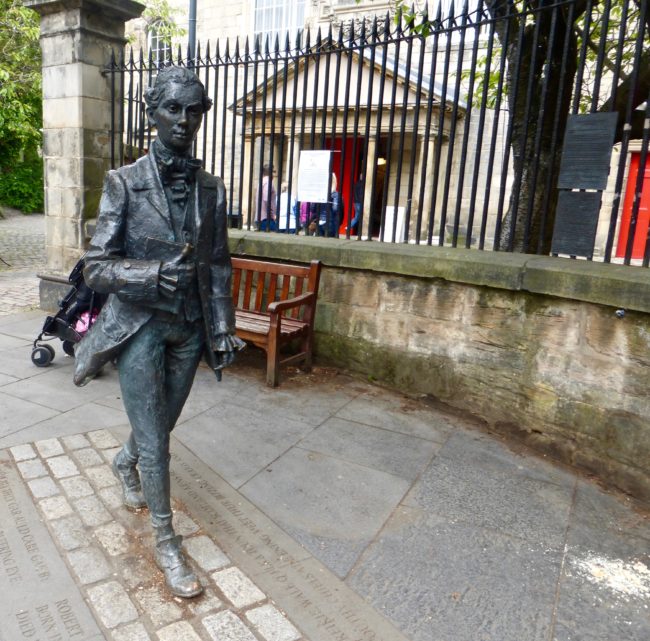 Across the street is the Museum of Edinburgh, but we were itching to see a controversially designed building, and, of course, Holyrood Palace. Had we known that there were possessions of a famed dog housed at the museum, we would have stepped in for a moment I’m sure.
Across the street is the Museum of Edinburgh, but we were itching to see a controversially designed building, and, of course, Holyrood Palace. Had we known that there were possessions of a famed dog housed at the museum, we would have stepped in for a moment I’m sure.
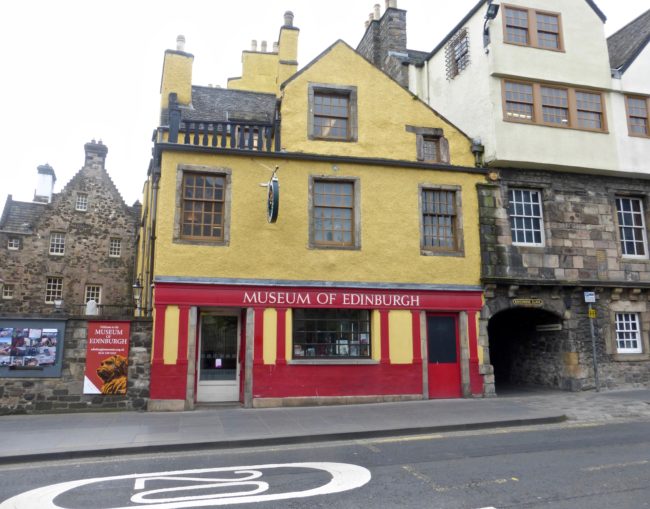 Coming in a little under half a billion pounds to build, the Scottish Parliament building is called by its detractors as “one of the ugliest buildings in the UK.” It was completed in 2004.
Coming in a little under half a billion pounds to build, the Scottish Parliament building is called by its detractors as “one of the ugliest buildings in the UK.” It was completed in 2004.
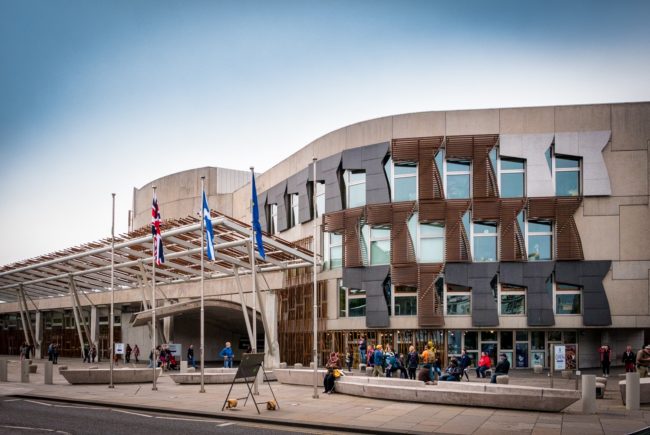 The “Debate Room” is unusual. The seating is arranged in a hemicycle, which I learned is a “horseshoe-shaped debating chamber.”
The “Debate Room” is unusual. The seating is arranged in a hemicycle, which I learned is a “horseshoe-shaped debating chamber.”
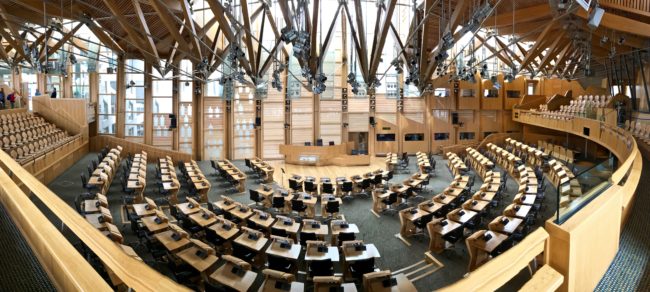 We all rather liked the unique building and its interior.
We all rather liked the unique building and its interior.
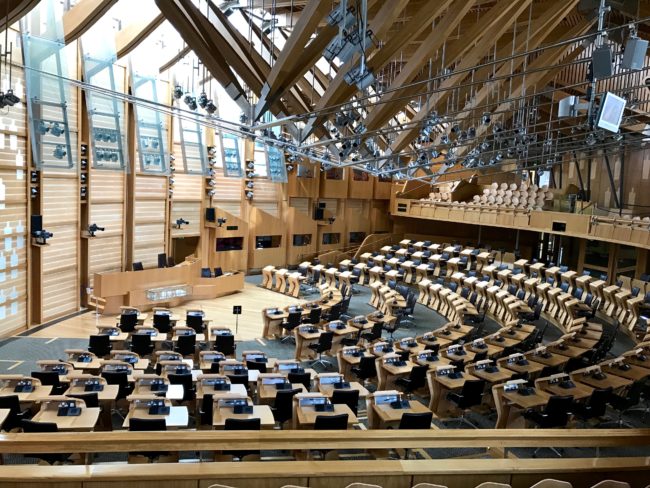 Now it was finally time for Holyrood Palace, not to be confused with the old television show hosted by the likes of Milton Berle, Bing Crosby or Jimmy Durante.
Now it was finally time for Holyrood Palace, not to be confused with the old television show hosted by the likes of Milton Berle, Bing Crosby or Jimmy Durante.
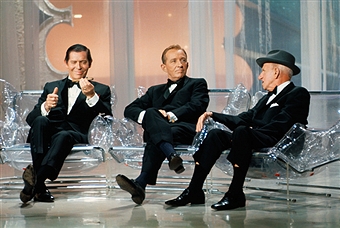 First we ran into more unicorns…
First we ran into more unicorns…
…outside the Queen’s Gallery.
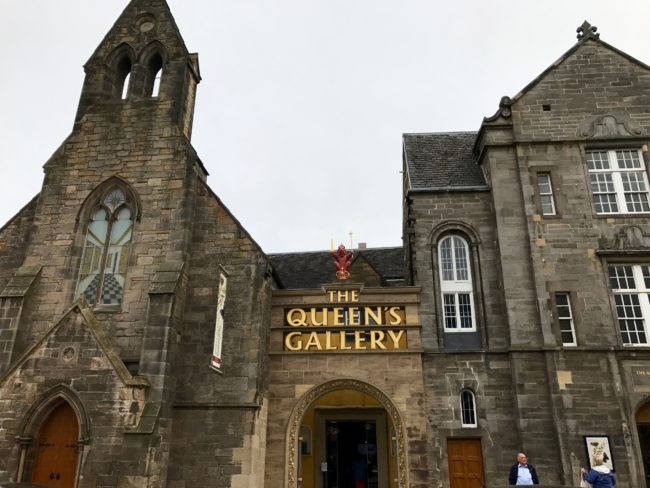 Unicorns seemingly were everywhere in Edinburgh, but we did not run into any green alligators or long-necked geese, because, I assumed, we weren’t in Ireland.
Unicorns seemingly were everywhere in Edinburgh, but we did not run into any green alligators or long-necked geese, because, I assumed, we weren’t in Ireland.
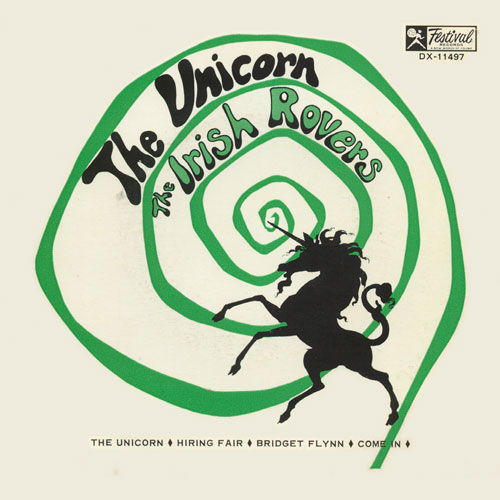 After crossing the street we saw an ominous sign posted. It read, “Sorry, Tom, Tracy, Kim and Mary, HRH The Princess Royal, Lord High Commissioner to the General Assembly of the Church of Scotland is in residence. You are SOL. Love, Anne.” At least I think that’s what it said. Downtrodden…
After crossing the street we saw an ominous sign posted. It read, “Sorry, Tom, Tracy, Kim and Mary, HRH The Princess Royal, Lord High Commissioner to the General Assembly of the Church of Scotland is in residence. You are SOL. Love, Anne.” At least I think that’s what it said. Downtrodden…
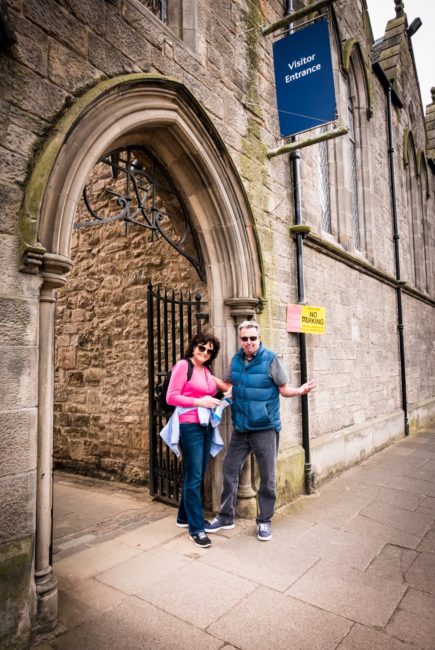 …all we could do was look through the gates and dream about the interior of the palace where Mary Queen of Scots lived. I couldn’t even muster the energy to sing, “Hooray for Holyrood.”
…all we could do was look through the gates and dream about the interior of the palace where Mary Queen of Scots lived. I couldn’t even muster the energy to sing, “Hooray for Holyrood.”
Suddenly the gates opened and out drove a couple of cars.
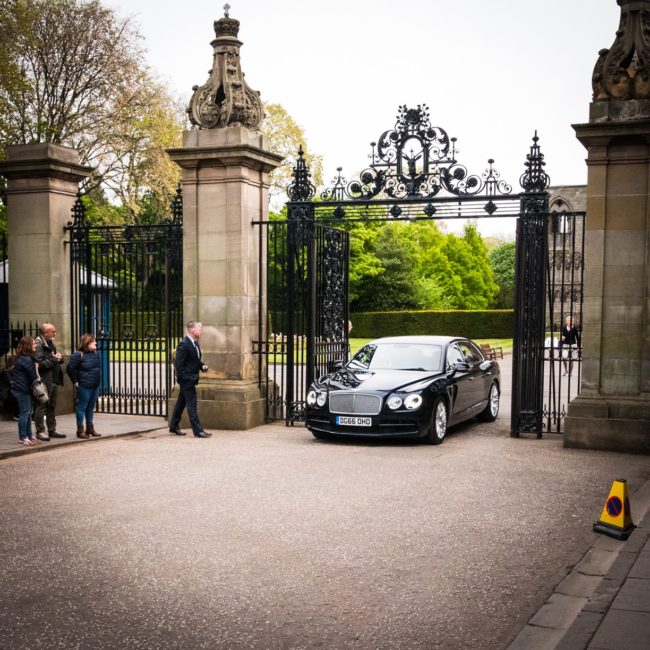 We don’t know if Anne was in either of them, but not even all the stuffed corgis at the store next door could give us solace.
We don’t know if Anne was in either of them, but not even all the stuffed corgis at the store next door could give us solace.
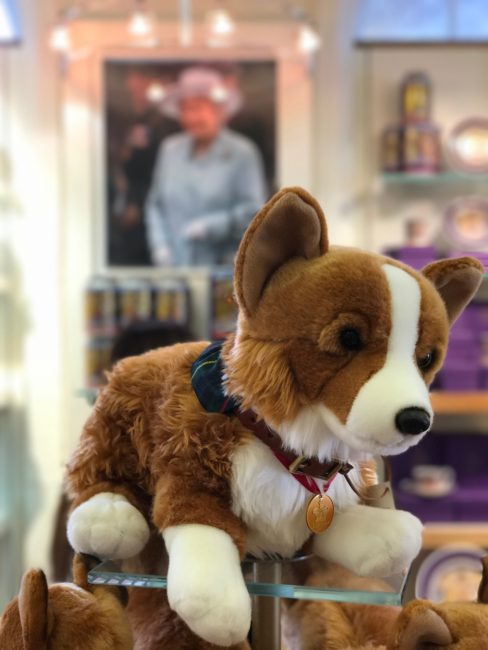 What did these disconsolate tourists do to ease the pain? Eat!!!!
What did these disconsolate tourists do to ease the pain? Eat!!!!
We walked up the Royal Mile and the end of the world approached (or was it The World’s End?). According to its propaganda; “Back in the 16th century Edinburgh was a walled city. The gates to the city were situated outside the pub, and the brass cobbles in the road represent their exact location. As far as the people of Edinburgh were concerned, the world outside these gates was no longer theirs.” I told Kim that it was the end of the world as we know it. He just replied, “And I feel fine.” We would have eaten there, but we had a dog to see.
We detoured off High Street and in ten minutes we were at Greyfriars Bobby (30-34 Candlemaker Row).
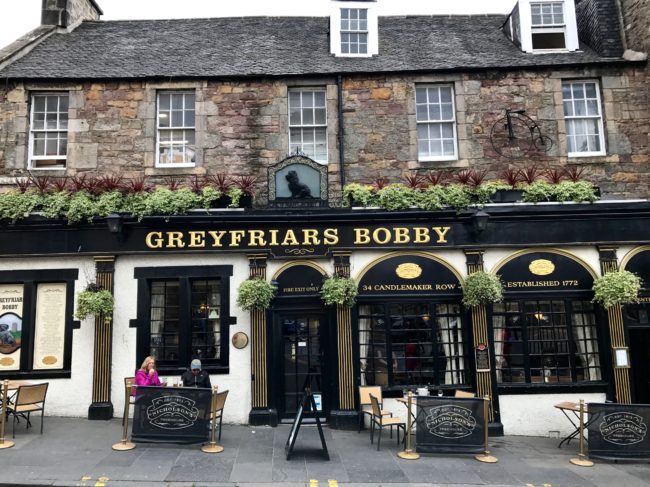 So the tale (or should I say “tail”) goes, Bobby was a Skye Terrier, who was inseparable from his owner John Gray, a night watchman for the Edinburgh Police. Sadly, in February 1858, Gray died of tuberculosis and was buried in the Greyfriars Kirkyard. For the next 14 years, loyal Bobby is said to have just sat on Gray’s grave every day (and I thought our dogs were lazy). At first, they tried to evict him, but eventually a shelter was set up for Bobby, who died in 1872. Dogs could not be buried in the cemetery itself, but Bobby was given a final resting place just inside the gate of Greyfriars Kirkyard, not too far away from his master.
So the tale (or should I say “tail”) goes, Bobby was a Skye Terrier, who was inseparable from his owner John Gray, a night watchman for the Edinburgh Police. Sadly, in February 1858, Gray died of tuberculosis and was buried in the Greyfriars Kirkyard. For the next 14 years, loyal Bobby is said to have just sat on Gray’s grave every day (and I thought our dogs were lazy). At first, they tried to evict him, but eventually a shelter was set up for Bobby, who died in 1872. Dogs could not be buried in the cemetery itself, but Bobby was given a final resting place just inside the gate of Greyfriars Kirkyard, not too far away from his master.
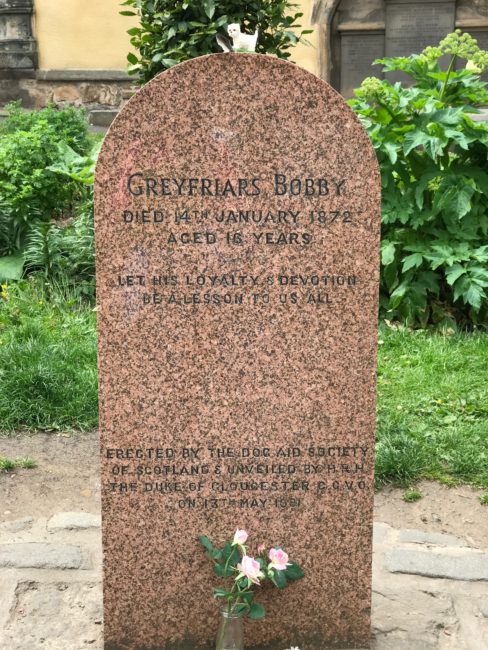 By the way, Bobby’s collar and dog bowl are at the Museum of Edinburgh, which we will visit on our next trip.
By the way, Bobby’s collar and dog bowl are at the Museum of Edinburgh, which we will visit on our next trip.
Greyfriar’s Kirkyard, located behind Greyfriars Bobby Bar, is said to be haunted, but we managed to walk around its grounds…
…and visit Greyfriars Kirk unscathed. For some reason, with Bobby buried nearby, I thought we’d find more bones.
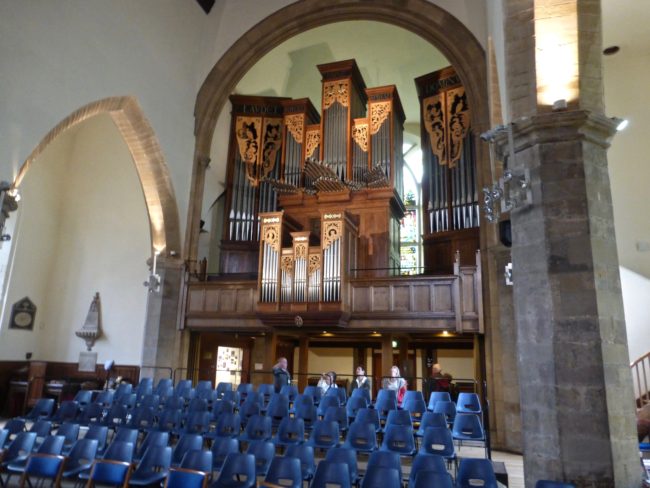 After the cemetery visit, we walked inside and were seated by a hostess who quickly became the Don Rickles of Greyfriars.
After the cemetery visit, we walked inside and were seated by a hostess who quickly became the Don Rickles of Greyfriars.
I ordered a half-pint of beer. “Half pints are for Jessie’s,” our hostess remarked. Not knowing at the time what that meant (aka “wimp”), but quickly getting the gist of her fake wrath, I quickly upped my order to a full pint. I didn’t tell her that Tracy sometimes has to open the jar lid for me. A little later as we talked about being shut out of Holyrood Palace due to Princess Anne’s visit, she muttered, “Nobody should inherit a title. Look at North Korea.” And she was still irked that, “Elizabeth killed Mary.” Every time she walked by, it was a one-liner.
In between her monologues, we ate. My Beef Pie with Creamy Mashed Potatoes had enough butter to stop your heart in mid-beat… “Wow!” I’m also addicted to this mustard after trying it here.
In front of Greyfriars stands the statue of Bobby. It is said that you should rub the nose of the little guy for good luck, which we, and many others did.
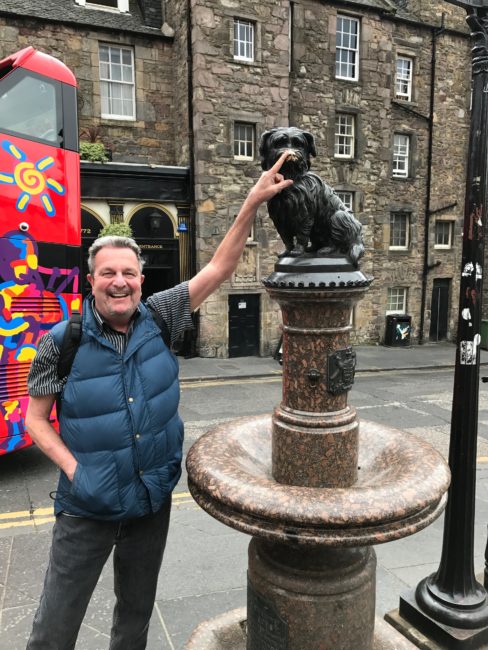 It wasn’t until we returned home that I found out that Edinburgh officials are trying to stop that activity, because Bobby’s nose gets easily damaged.
It wasn’t until we returned home that I found out that Edinburgh officials are trying to stop that activity, because Bobby’s nose gets easily damaged.
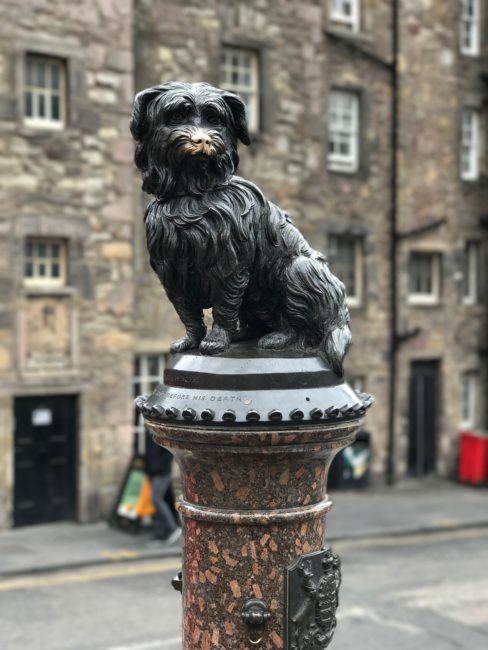 A few years ago officials tried to fix it, but after two days the nose was in bad shape again. It must have been the worst nose job since Jennifer Grey’s.
A few years ago officials tried to fix it, but after two days the nose was in bad shape again. It must have been the worst nose job since Jennifer Grey’s.
 Not too far from the bar is the Elephant House (21 George IV Bridge), a gourmet tea and coffee house. This is where J.K. Rowling hung out and wrote some of her early novels in the back room overlooking Edinburgh Castle. Being the Muggle that I am, I told the crew to press on…we had a castle to see.
Not too far from the bar is the Elephant House (21 George IV Bridge), a gourmet tea and coffee house. This is where J.K. Rowling hung out and wrote some of her early novels in the back room overlooking Edinburgh Castle. Being the Muggle that I am, I told the crew to press on…we had a castle to see.
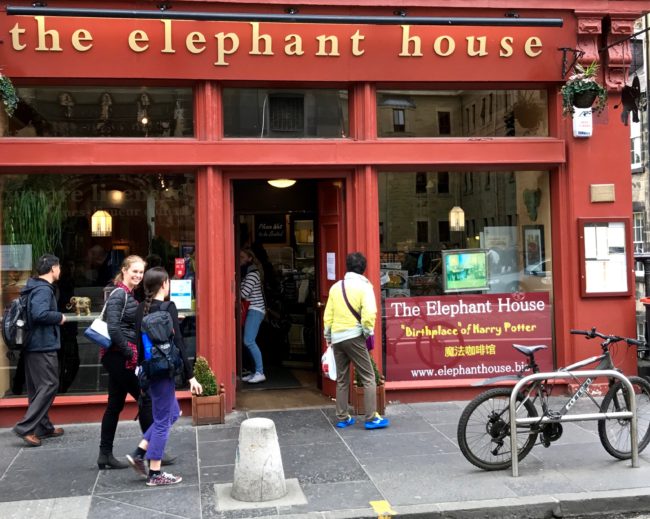 On we trudged up…and up…and up to the castle. After a few stops for oxygen, we were at the statues of Scotland’s famed Freedom Fighters, William Wallace and Robert The Bruce, who kind of resembles Steve McQueen. Wallace, however, bore no resemblance to Mel Gibson.
On we trudged up…and up…and up to the castle. After a few stops for oxygen, we were at the statues of Scotland’s famed Freedom Fighters, William Wallace and Robert The Bruce, who kind of resembles Steve McQueen. Wallace, however, bore no resemblance to Mel Gibson.
Inside we activated our Explorer Pass (which we had elected to buy instead of the Heritage Pass…more on that as we travel through the countryside), which also afforded us a 20% discount on the audio guide and, of course, the opportunity to skip the ticket line.
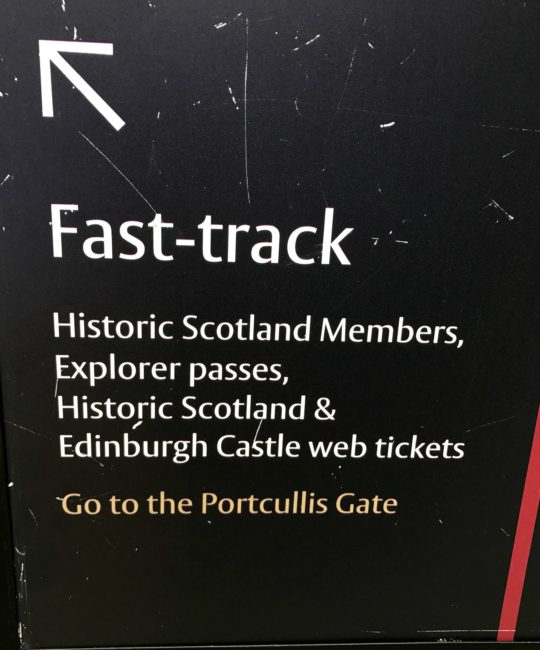 Continuing with our upward momentum, we were rewarded with nice views of Edinburgh, cannon notwithstanding.
Continuing with our upward momentum, we were rewarded with nice views of Edinburgh, cannon notwithstanding.
This courtyard contains an equestrian statue of the second Earl Haig. For almost 90 years, the monument commissioned to honor Borders military commander Field Marshal Sir Douglas Haig and his welfare work for ex-servicemen, stood on the esplanade of Edinburgh Castle, but it was moved here to help in preserving and protecting it.
Not in any particular order, here are some of the castle highlights.
The Scottish National War Memorial truly is a masterpiece both inside and out. It commemorates the dead of both world wars and of military campaigns since 1945. The memorial was opened in 1927 by the Prince of Wales (no photos allowed inside unfortunately..one below is from internet).
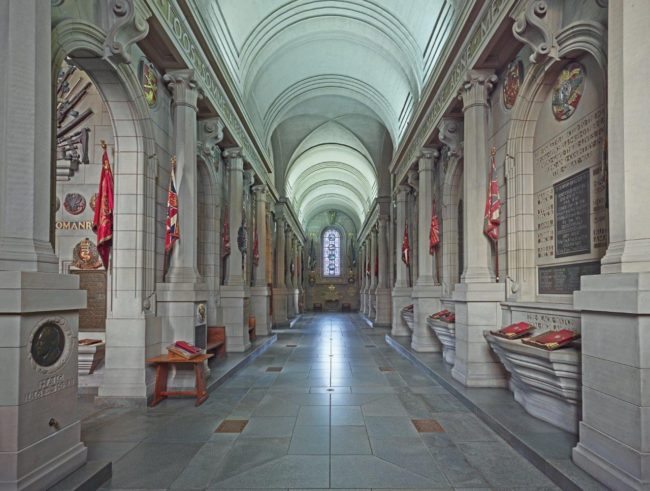 Located in front is this sculpture of a unicorn…
Located in front is this sculpture of a unicorn…
Signs throughout the complex keep you from getting lost…and this guy guards the Regimental Museum.
The Great Hall was completed in 1511 for King James IV and is located in the heart of the castle.
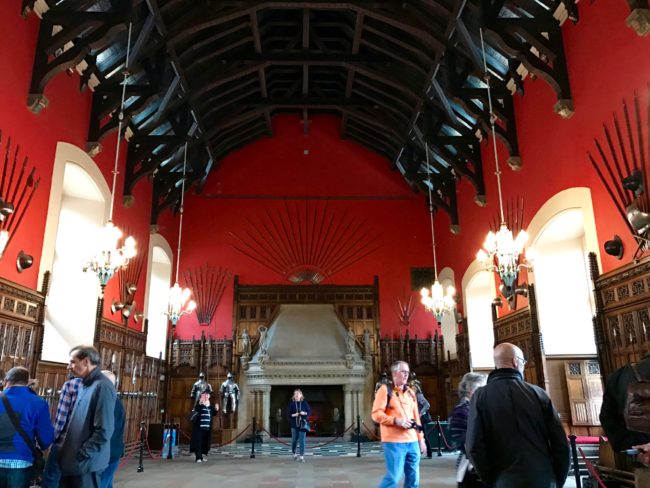 Sadly, he didn’t get to spend much time at the Great Hall as he was killed at the Battle of Flodden in 1513 while fighting the forces of Henry VIII.
Sadly, he didn’t get to spend much time at the Great Hall as he was killed at the Battle of Flodden in 1513 while fighting the forces of Henry VIII.
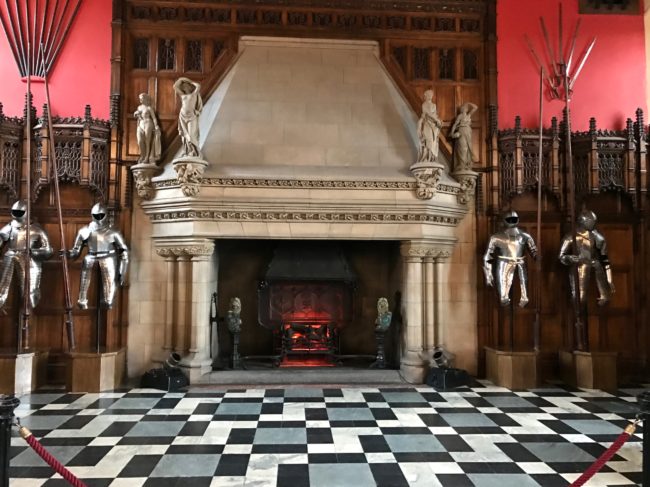 As in every great hall in every castle, knights and armor reigned supreme. In 1650, Oliver Cromwell converted it into soldier’s barracks, and it was restored in 1887. It is still used for state and royal functions.
As in every great hall in every castle, knights and armor reigned supreme. In 1650, Oliver Cromwell converted it into soldier’s barracks, and it was restored in 1887. It is still used for state and royal functions.
No pictures in the Crown Jewels Room either, so this is stolen off the internet, which is much safer than attempting to steal the Crown Jewels.
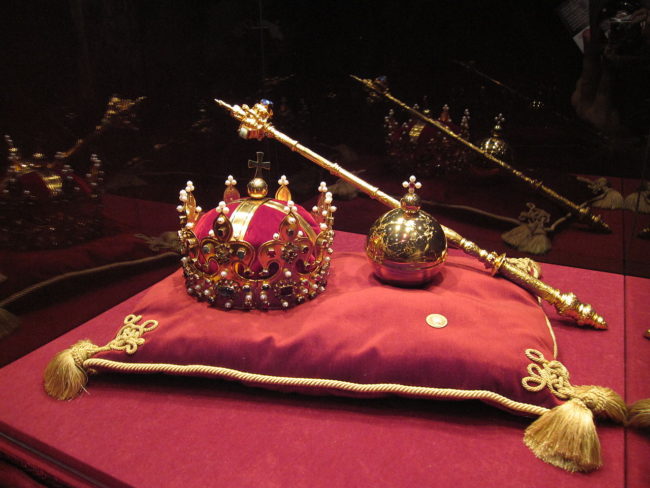 St. Margaret’s Chapel is where the royals worshipped. Built in the 1100s by David I, it was dedicated to his mother Queen Margaret.
St. Margaret’s Chapel is where the royals worshipped. Built in the 1100s by David I, it was dedicated to his mother Queen Margaret.
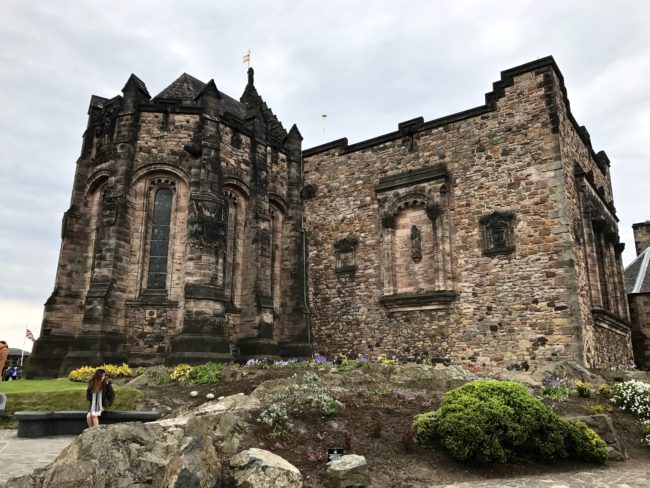 It’s crowded, but you can step inside for a moment to check out the altar and stained glass windows.
It’s crowded, but you can step inside for a moment to check out the altar and stained glass windows.
Bringing out its big gun, nearby is Mon’s Meg, which at one time was at the cutting edge of military technology.
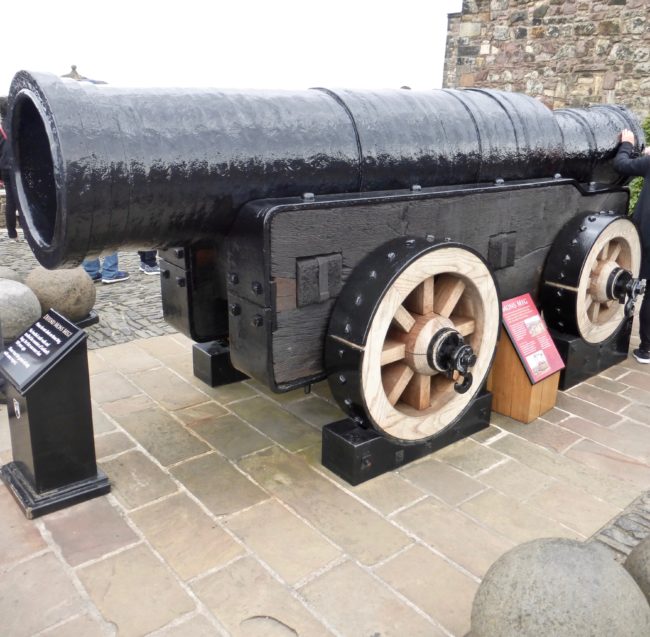 We checked out the Half Moon Battery.
We checked out the Half Moon Battery.
Ninety minutes walking around the castle gave us ample opportunity to catch many different views from various vantage points… including this view of a church near Princes Street Gardens that we thought we’d check out while we were in town…
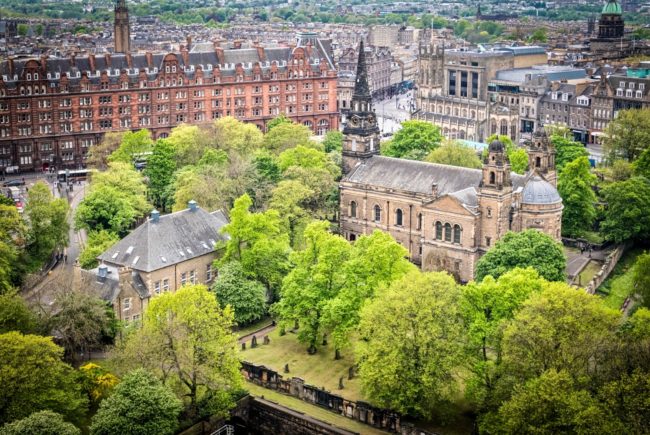 …and another capturing the cemetery for Soldiers’ Dogs.
…and another capturing the cemetery for Soldiers’ Dogs.
…and it was time to leave. As we left, others were still marching inside.
Just like at Windsor Castle, they attempted to lure us to stay with ice cream.
Make a point to visit the castle if you have the chance.
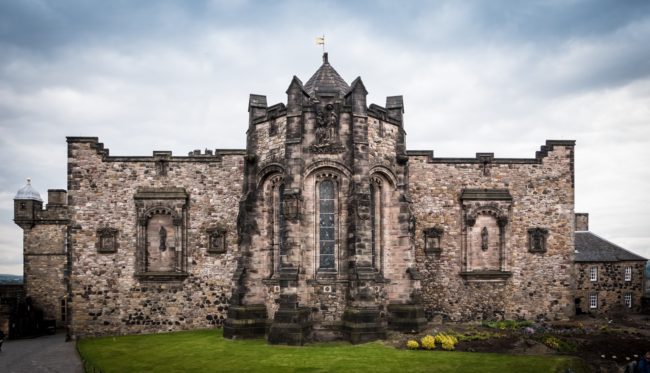 Tracy and Mary were in a shopping mood, and they lured Kim and me into what looked like a small store near the castle. Instead the interior resembled an Amazon warehouse. We would return on our final day.
Tracy and Mary were in a shopping mood, and they lured Kim and me into what looked like a small store near the castle. Instead the interior resembled an Amazon warehouse. We would return on our final day.
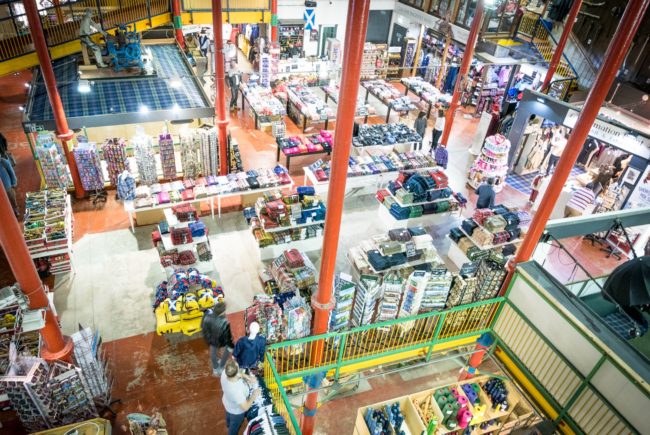 Because we had only walked about 100 miles, we foolishly attempted to walk back to Millers64. At one store, Kim thought they should buy this book for their grandchildren with the cover featuring an uncanny likeness of the 45th president. Mary vetoed the idea and fired Kim.
Because we had only walked about 100 miles, we foolishly attempted to walk back to Millers64. At one store, Kim thought they should buy this book for their grandchildren with the cover featuring an uncanny likeness of the 45th president. Mary vetoed the idea and fired Kim.
 She did buy something called Jelly Cat, which is not available in the United States, and I have no idea what that is.
She did buy something called Jelly Cat, which is not available in the United States, and I have no idea what that is.
Along our walk, Tracy spotted a thistle, the national emblem of Scotland. This one was real and she grabbed a quick photo.
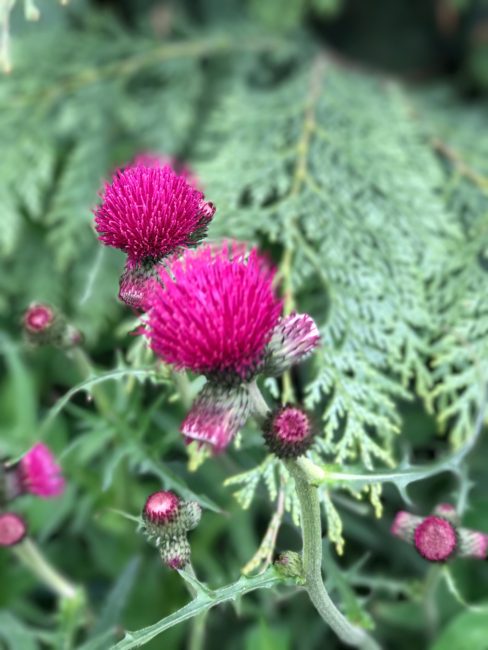 A taxi soon approached, and we willingly hopped in after waving it down. We actually had a little time to rest before dinner, but then it was back on our feet again for the 15-20 minute walk to a nearby French restaurant.
A taxi soon approached, and we willingly hopped in after waving it down. We actually had a little time to rest before dinner, but then it was back on our feet again for the 15-20 minute walk to a nearby French restaurant.
I had made reservations at L’Escargot Bleu (56 Broughton Street), and it so happened that Louise is friends with them, so we got some royal treatment (although it looked like everyone received great service).
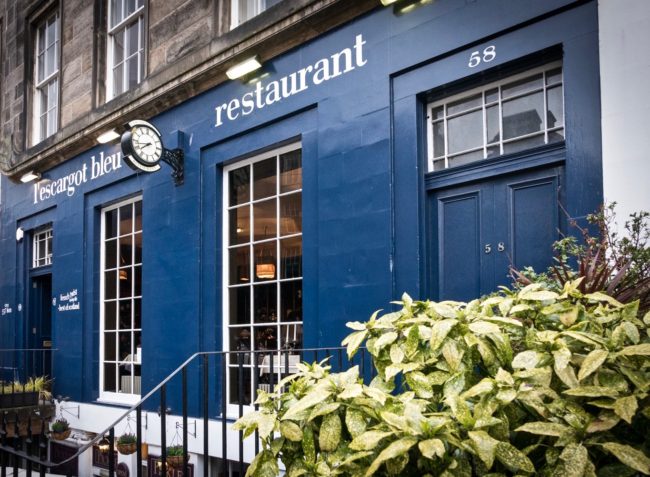 The restaurant touts its “French twist using the best of Scotland” menu. The interior was charming, and the meal got off to a rousing start.
The restaurant touts its “French twist using the best of Scotland” menu. The interior was charming, and the meal got off to a rousing start.
We were offered an amuse bouche of whipped chicken liver paté on a cracker. Thankfully Kim did not want his, so I was the lucky recipient of two. He did take a lovely photo, however.
Next up, I flew over the moon with this restaurant’s Steak Tartare, served table-side. I was able to pick the ingredients and the hotness strength of the dish. I chose a “7” (out of ten). It was (and it’s really not even close) my favorite Steak Tartare ever. Next time, I’m going for a “9!” “Wow!!”
I also enjoyed the Heritage Pig special. The server told us Heritage pigs have curly hair (fortunately not in the dish) and are very unusual in Scotland…it was quite good.
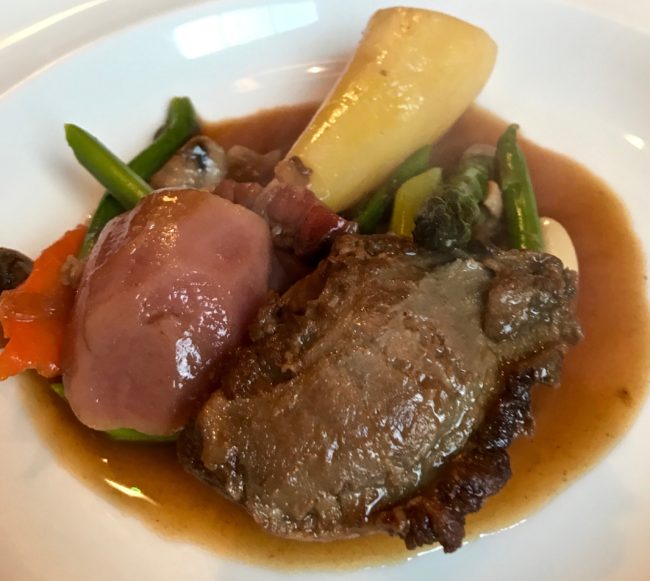 Tracy started with baked escargot and followed that up with Pork Cheek Casserole.
Tracy started with baked escargot and followed that up with Pork Cheek Casserole.
Kim’s salad would have given him his 5 A Day allotment, but he traded with Mary for her vegetable soup when he found out it contained tomatoes (Eat your tomatoes!!). They each had a faux filet.
I finally ordered my first Sticky Toffee Pudding of the trip, but my greedy cohorts stuck their utensils in and I was forced at fork-point to share. I’m coming here alone next time!
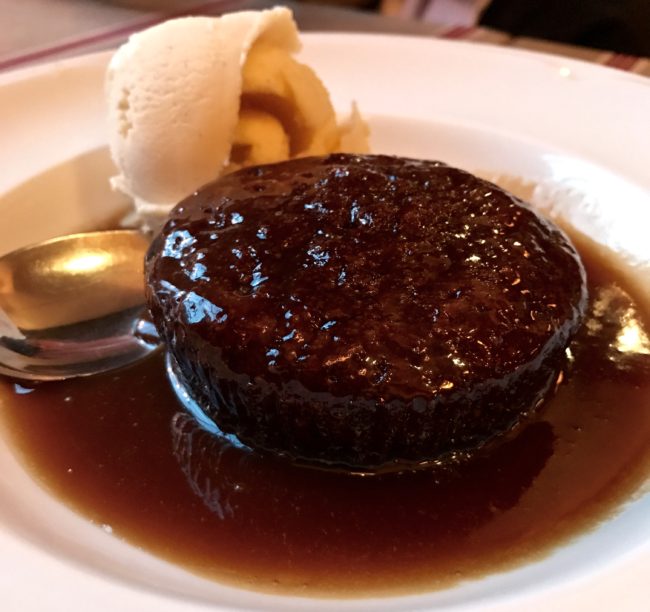 Thankfully, Louise had called the restaurant and once we paid, they ordered a taxi for our return (she must have seen my companions’ tired faces when we left the b&B).
Thankfully, Louise had called the restaurant and once we paid, they ordered a taxi for our return (she must have seen my companions’ tired faces when we left the b&B).
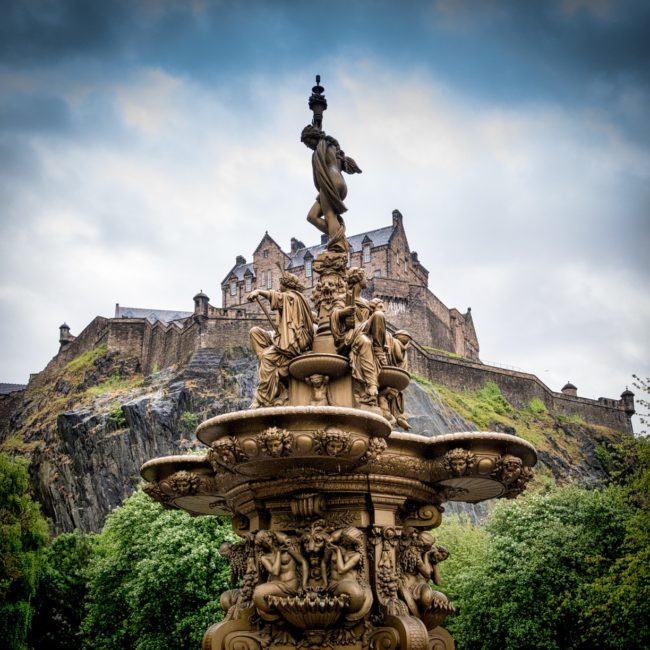 We had logged 12 1/2 miles on our weary puppies, and they needed rest for tomorrow, because there was no stopping us now!
We had logged 12 1/2 miles on our weary puppies, and they needed rest for tomorrow, because there was no stopping us now!
On Saturday, we’d check out another Sargent that Tracy fell immediately in love with and took a walk through Princes Street Gardens to a beautiful church with an even more gorgeous cemetery. We would then visit another church, tour an historic house, attempt to see a nearby village, stop in a pub before a downpour of biblical proportions and enjoy a decadent tea amidst peacocks, bagpipes and a wedding. After a brief (key word being “brief”) respite at our b&b, I’d rally the troops for a visit to a part of Edinburgh that we ended up loving, including magnificent sunset views and drinks at an historic pub.
Next: Day Six – Magnificent Museum, Not Related To Spiro, Prince & The Paupers, Closed Kirk, Remembering Bob, Unique Ceiling, No We’re Not In Atlanta, It Takes A Village (Sort of), Climbing Everest Would Be Easier, Any Pub In A Storm, Disheveled Guests, Our Foursome Has A Tea Time, So This Is What 20,000 Calories Tastes Like, Don’t Fowl Up This Wedding, Sunset Of Our Lives and Happy 500th Birthday!

